Research using animals: an overview
Around half the diseases in the world have no treatment. Understanding how the body works and how diseases progress, and finding cures, vaccines or treatments, can take many years of painstaking work using a wide range of research techniques. There is overwhelming scientific consensus worldwide that some research using animals is still essential for medical progress.
Animal research in the UK is strictly regulated. For more details on the regulations governing research using animals, go to the UK regulations page .
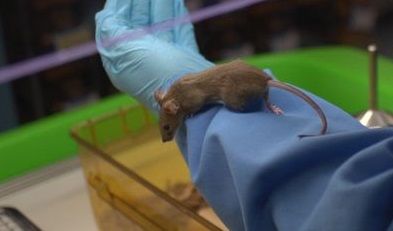

Why is animal research necessary?
There is overwhelming scientific consensus worldwide that some animals are still needed in order to make medical progress.
Where animals are used in research projects, they are used as part of a range of scientific techniques. These might include human trials, computer modelling, cell culture, statistical techniques, and others. Animals are only used for parts of research where no other techniques can deliver the answer.
A living body is an extraordinarily complex system. You cannot reproduce a beating heart in a test tube or a stroke on a computer. While we know a lot about how a living body works, there is an enormous amount we simply don’t know: the interaction between all the different parts of a living system, from molecules to cells to systems like respiration and circulation, is incredibly complex. Even if we knew how every element worked and interacted with every other element, which we are a long way from understanding, a computer hasn’t been invented that has the power to reproduce all of those complex interactions - while clearly you cannot reproduce them all in a test tube.
While humans are used extensively in Oxford research, there are some things which it is ethically unacceptable to use humans for. There are also variables which you can control in a mouse (like diet, housing, clean air, humidity, temperature, and genetic makeup) that you could not control in human subjects.
Is it morally right to use animals for research?
Most people believe that in order to achieve medical progress that will save and improve lives, perhaps millions of lives, limited and very strictly regulated animal use is justified. That belief is reflected in the law, which allows for animal research only under specific circumstances, and which sets out strict regulations on the use and care of animals. It is right that this continues to be something society discusses and debates, but there has to be an understanding that without animals we can only make very limited progress against diseases like cancer, heart attack, stroke, diabetes, and HIV.
It’s worth noting that animal research benefits animals too: more than half the drugs used by vets were developed originally for human medicine.
Aren’t animals too different from humans to tell us anything useful?
No. Just by being very complex living, moving organisms they share a huge amount of similarities with humans. Humans and other animals have much more in common than they have differences. Mice share over 90% of their genes with humans. A mouse has the same organs as a human, in the same places, doing the same things. Most of their basic chemistry, cell structure and bodily organisation are the same as ours. Fish and tadpoles share enough characteristics with humans to make them very useful in research. Even flies and worms are used in research extensively and have led to research breakthroughs (though these species are not regulated by the Home Office and are not in the Biomedical Sciences Building).
What does research using animals actually involve?
The sorts of procedures research animals undergo vary, depending on the research. Breeding a genetically modified mouse counts as a procedure and this represents a large proportion of all procedures carried out. So does having an MRI (magnetic resonance imaging) scan, something which is painless and which humans undergo for health checks. In some circumstances, being trained to go through a maze or being trained at a computer game also counts as a procedure. Taking blood or receiving medication are minor procedures that many species of animal can be trained to do voluntarily for a food reward. Surgery accounts for only a small minority of procedures. All of these are examples of procedures that go on in Oxford's Biomedical Sciences Building.
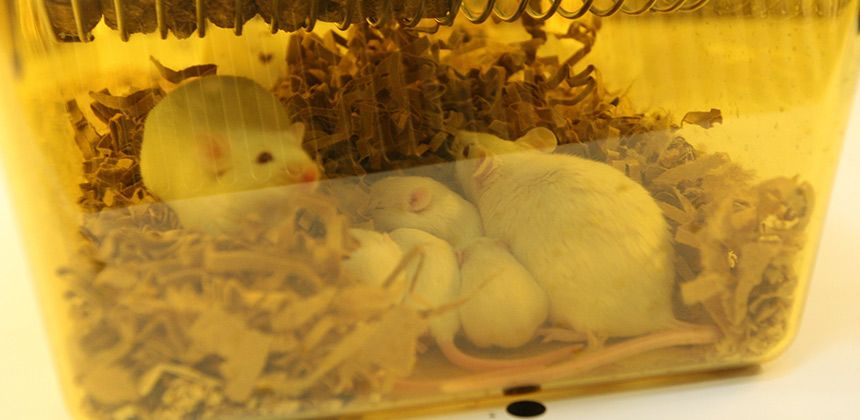
How many animals are used?
Figures for 2023 show numbers of animals that completed procedures, as declared to the Home Office using their five categories for the severity of the procedure.
| 1705 | 278 | 7 | 41 | 0 | 0 | 9 | 9 | 0 | 0 | 0 | 0 |
|
| 36384 | 160 | 3 | 7 | 29 | 1 | 33 | 0 | 45 | 0 | 1458 | 0 |
|
| 27350 | 76 | 11 | 0 | 0 | 9 | 0 | 12 | 0 | 0 | 90 | 113 |
|
| 2059 | 9 | 0 | 0 | 0 | 0 | 0 | 0 | 0 | 0 | 56 | 15 |
|
| 124541 | 88 | 0 | 0 | 0 | 0 | 0 | 0 | 0 | 0 | 315 | 0 |
|
|
|
|
|
|
|
|
|
|
|
|
|
|
|
# NHPs - Non Human Primates
Oxford also maintains breeding colonies to provide animals for use in experiments, reducing the need for unnecessary transportation of animals.
Figures for 2017 show numbers of animals bred for procedures that were killed or died without being used in procedures:
8851 | 2000 | 23721 | 34572 | |
762 | 0 | 0 | 762 | |
59 | 0 | 0 | 59 | |
384 | 0 | 0 | 384 |
Why must primates be used?
Primates account for under half of one per cent (0.5%) of all animals housed in the Biomedical Sciences Building. They are only used where no other species can deliver the research answer, and we continually seek ways to replace primates with lower orders of animal, to reduce numbers used, and to refine their housing conditions and research procedures to maximise welfare.
However, there are elements of research that can only be carried out using primates because their brains are closer to human brains than mice or rats. They are used at Oxford in vital research into brain diseases like Alzheimer’s and Parkinson’s. Some are used in studies to develop vaccines for HIV and other major infections.
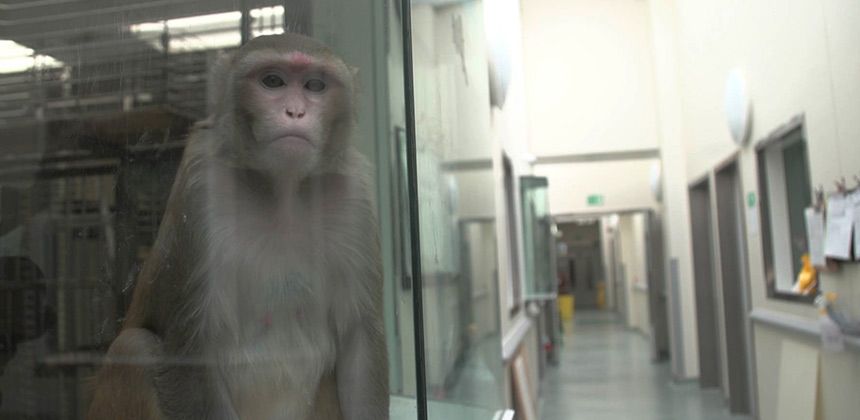
What is done to primates?
The primates at Oxford spend most of their time in their housing. They are housed in groups with access to play areas where they can groom, forage for food, climb and swing.
Primates at Oxford involved in neuroscience studies would typically spend a couple of hours a day doing behavioural work. This is sitting in front of a computer screen doing learning and memory games for food rewards. No suffering is involved and indeed many of the primates appear to find the games stimulating. They come into the transport cage that takes them to the computer room entirely voluntarily.
After some time (a period of months) demonstrating normal learning and memory through the games, a primate would have surgery to remove a very small amount of brain tissue under anaesthetic. A full course of painkillers is given under veterinary guidance in the same way as any human surgical procedure, and the animals are up and about again within hours, and back with their group within a day. The brain damage is minor and unnoticeable in normal behaviour: the animal interacts normally with its group and exhibits the usual natural behaviours. In order to find out about how a disease affects the brain it is not necessary to induce the equivalent of full-blown disease. Indeed, the more specific and minor the brain area affected, the more focussed and valuable the research findings are.
The primate goes back to behavioural testing with the computers and differences in performance, which become apparent through these carefully designed games, are monitored.
At the end of its life the animal is humanely killed and its brain is studied and compared directly with the brains of deceased human patients.
Primates at Oxford involved in vaccine studies would simply have a vaccination and then have monthly blood samples taken.
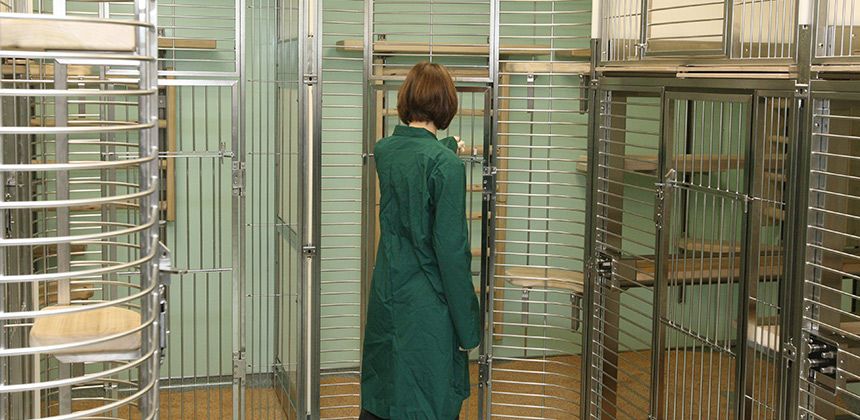
How many primates does Oxford hold?
| Year | Total number of primates held (number at mid-point of year) | Number of primates on procedure (as recorded in annual Home Office returns) |
| 2004 | 109 | 20 |
| 2005 | 109 | 22 |
| 2006 | 100 | 49 |
| 2007 | 99 | 39 |
| 2008 | 86 | 66 |
| 2009 | 98 | 49 |
| 2010 | 80 | 41 |
| 2011 | 55 | 22 |
| 2012 | 46 | 29 |
| 2013 | 41 | 45 |
| 2014 | 38 | 5* |
| 2015 | 50 | 2* |
| 2016 | 52 | 8 |
| 2017 | 54 | 7 |
| 2018 | 52 | 10 |
* From 2014 the Home Office changed the way in which animals/ procedures were counted. Figures up to and including 2013 were recorded when procedures began. Figures from 2014 are recorded when procedures end.
What’s the difference between ‘total held’ and ‘on procedure’?
Primates (macaques) at Oxford would typically spend a couple of hours a day doing behavioural work, sitting in front of a computer screen doing learning and memory games for food rewards. This is non-invasive and done voluntarily for food rewards and does not count as a procedure. After some time (a period of months) demonstrating normal learning and memory through the games, a primate would have surgery under anaesthetic to remove a very small amount of brain tissue. The primate quickly returns to behavioural testing with the computers, and differences in performance, which become apparent through these carefully designed puzzles, are monitored. A primate which has had this surgery is counted as ‘on procedure’. Both stages are essential for research into understanding brain function which is necessary to develop treatments for conditions including Alzheimer’s, Parkinson’s and schizophrenia.
Why has the overall number held gone down?
Numbers vary year on year depending on the research that is currently undertaken. In general, the University is committed to reducing, replacing and refining animal research.
You say primates account for under 0.5% of animals, so that means you have at least 16,000 animals in the Biomedical Sciences Building in total - is that right?
Numbers change daily so we cannot give a fixed figure, but it is in that order.
Aren’t there alternative research methods?
There are very many non-animal research methods, all of which are used at the University of Oxford and many of which were pioneered here. These include research using humans; computer models and simulations; cell cultures and other in vitro work; statistical modelling; and large-scale epidemiology. Every research project which uses animals will also use other research methods in addition. Wherever possible non-animal research methods are used. For many projects, of course, this will mean no animals are needed at all. For others, there will be an element of the research which is essential for medical progress and for which there is no alternative means of getting the relevant information.
How have humans benefited from research using animals?
As the Department of Health states, research on animals has contributed to almost every medical advance of the last century.
Without animal research, medicine as we know it today wouldn't exist. It has enabled us to find treatments for cancer, antibiotics for infections (which were developed in Oxford laboratories), vaccines to prevent some of the most deadly and debilitating viruses, and surgery for injuries, illnesses and deformities.
Life expectancy in this country has increased, on average, by almost three months for every year of the past century. Within the living memory of many people diseases such as polio, tuberculosis, leukaemia and diphtheria killed or crippled thousands every year. But now, doctors are able to prevent or treat many more diseases or carry out life-saving operations - all thanks to research which at some stage involved animals.
Each year, millions of people in the UK benefit from treatments that have been developed and tested on animals. Animals have been used for the development of blood transfusions, insulin for diabetes, anaesthetics, anticoagulants, antibiotics, heart and lung machines for open heart surgery, hip replacement surgery, transplantation, high blood pressure medication, replacement heart valves, chemotherapy for leukaemia and life support systems for premature babies. More than 50 million prescriptions are written annually for antibiotics.
We may have used animals in the past to develop medical treatments, but are they really needed in the 21st century?
Yes. While we are committed to reducing, replacing and refining animal research as new techniques make it possible to reduce the number of animals needed, there is overwhelming scientific consensus worldwide that some research using animals is still essential for medical progress. It only forms one element of a whole research programme which will use a range of other techniques to find out whatever possible without animals. Animals would be used for a specific element of the research that cannot be conducted in any alternative way.
How will humans benefit in future?
The development of drugs and medical technologies that help to reduce suffering among humans and animals depends on the carefully regulated use of animals for research. In the 21st century scientists are continuing to work on treatments for cancer, stroke, heart disease, HIV, malaria, tuberculosis, diabetes, neurodegenerative diseases like Alzheimer's and Parkinson’s, and very many more diseases that cause suffering and death. Genetically modified mice play a crucial role in future medical progress as understanding of how genes are involved in illness is constantly increasing.
- The Importance of Animal Research
- BIOMEDICAL RESEARCH

Research Advancing Health
The goal of biomedical research is to translate discoveries and observations in the laboratory or clinic into new therapies. Biomedical research methods range from predictive studies to those that involve whole living systems. Areas of study may include (1) gross populations, (2) individual human subjects, (3) nonhuman animals, (4) in vitro techniques using cells and tissues from humans, animals or even plants, (5) microorganisms including bacteria, yeast or viruses, and even (6) molecular analyses of genes, proteins and other biomolecules. Animal models are utilized in biomedical research when questions require a study of whole organisms that cannot be carried out in humans.

Typically, animal studies are essential for research that seeks to understand complex questions of disease progression, genetics, lifetime risk or other biological mechanisms of a whole living system that would be unethical, morally unacceptable or technically unfeasible or too difficult to perform in human subjects. The most common laboratory animal in biomedical research are purpose bred rats and transgenic mice. In fact, approximately 95% of all warm-blooded laboratory animals are rodents. The contributions made by these animals and other species help researchers answer questions of biological uncertainty and are necessary and critical to the advancement of both human and animal health.
Other very important aids include mathematical modeling, database analysis, computer simulations and in vitro models, such as cell and tissue cultures. These computational methods are utilized to analyze large volumes of historical experimental data in order to highlight biological trends and high priority research objectives, as well as to compile large volumes of experimental data into virtual biological systems and networks that, within the bounds of current knowledge, are capable of making predictive assessments of research questions.
The focus of biomedical researchers are diverse, but all seek to answer questions relevant to human and animal health that may one day translate into clinical practice. Research programs can be found in public health, epidemiology, preventive medicine, epigenetics, cancer, aging, endocrinology, neuroendocrinology, diabetes, cellular biology, molecular biology, pharmacology, psychopharmacology, neuroscience, genetics, virology and much more.
Role of Animal Research in Medical Advances
Virtually every major medical advance of the last century has depended upon research with animals. Animals have served as surrogates in the investigation of human diseases and have yielded valuable data in the process of discovering new ways to treat, cure or prevent them. From immunizations to cancer therapy, our ability to manage the health of animals has also improved because of animal research and the application of medical breakthroughs in veterinary medicine.
While a majority of the American public supports the necessary use of animals in biomedical research, they are also concerned about the care and treatment of laboratory animals. NABR, along with the scientific community, is committed to ensuring that all research conducted is ethical, responsible and humane.

The close relationship between dogs and people may pre-date recorded history. Over millennia, dogs have become our most beloved pets and also our hardest working partners. They guide those with special needs; help police, fire and rescue personnel; and even assist in herding other animals. One of the most significant results of our partnership with dogs has been their contribution to our understanding of disease, and how to prevent and cure it. In fact, dogs and people get many of the same diseases, from heart disease to cancer. What we can glean from studying dogs in medical and scientific research often yields treatments that help not only people, but also dogs themselves.

Mice and Rats
Rodents play an invaluable role in biomedical research. Approximately 95% of all laboratory animals are mice and rats. Reducing reliance on higher-order species, rodents have become the animal model of choice for biomedical researchers because their physiology and genetic makeup closely resembles that of people. Despite certain differences between people and rodents, the similarities are strong enough to give researchers an enormously powerful and versatile mammalian system in which to investigate human disease.
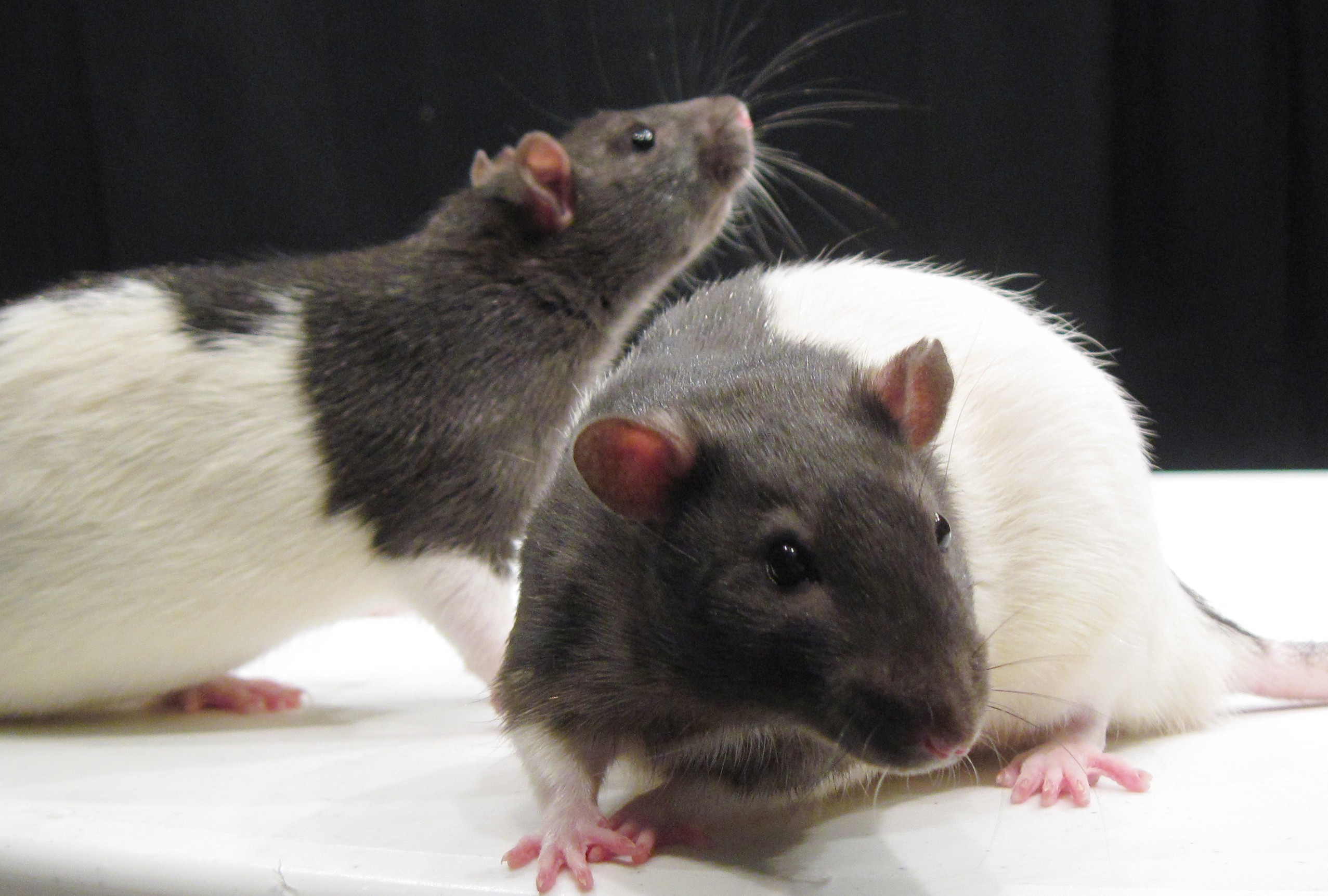
Non-Human Primates
Medical advances are usually built on a foundation of basic biomedical research and the application of newly found knowledge is often proved feasible in non-human primate (NHPs) models. Although irreplaceable in many types of research, only about 1/4 of 1% of animals used in research in the U.S. are NHPs and most of these animals are species of monkeys, not chimpanzees or other great apes. Historically, the polio vaccine, blood transfusions and organ transplantation among many other advances could not have been possible without NHP research.
Read here how non-human primates are helping in curing diseases

Medical Progress and Biomedical Research The Nobel Laureates
Every Nobel Prize in Medicine awarded in the last three decades was dependent on data from animal models. Overall, 83% of the Nobel Prizes awarded for outstanding contributions to medicine have involved animal research since the program was founded in 1901, more than 100 years ago. To learn more about the lab animals that have made important contributions in nearly every Nobel Prize in medicine, click here to find out more from the Foundation of Biomedical Research website.
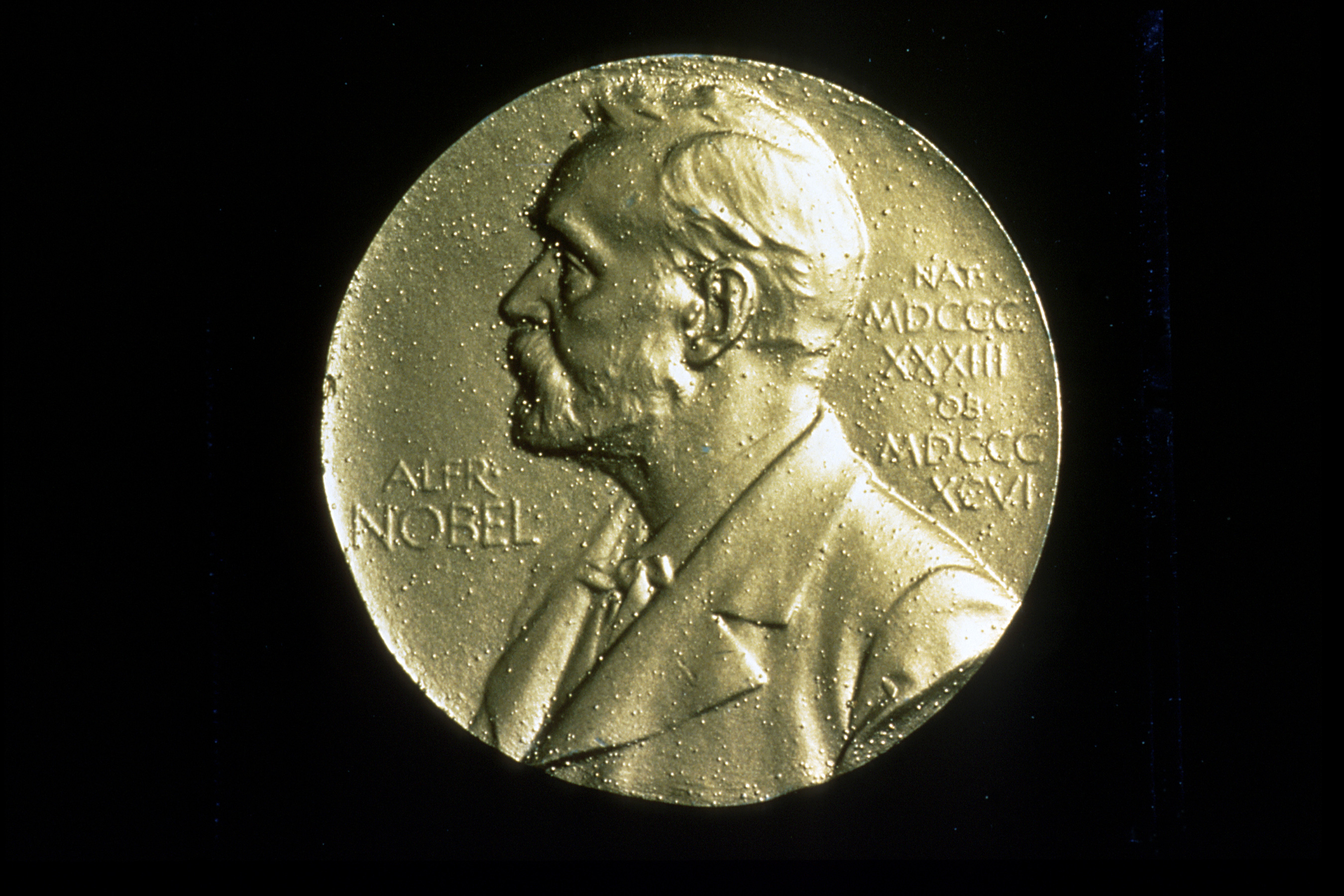
THE ANIMAL RESEARCH BEHIND THE TOP 25 MOST PRESCRIBED DRUGS
Animal research and testing were needed for every prescription medicine available today. The U.S. Food and Drug Administration (FDA) requires animal testing to ensure the safety of many drugs and devices.
Please click here to find out about the Top 25 Drugs from Foundation of Biomedical Research website.

An official website of the United States government
The .gov means it’s official. Federal government websites often end in .gov or .mil. Before sharing sensitive information, make sure you’re on a federal government site.
The site is secure. The https:// ensures that you are connecting to the official website and that any information you provide is encrypted and transmitted securely.
- Publications
- Account settings
- My Bibliography
- Collections
- Citation manager
Save citation to file
Email citation, add to collections.
- Create a new collection
- Add to an existing collection
Add to My Bibliography
Your saved search, create a file for external citation management software, your rss feed.
- Search in PubMed
- Search in NLM Catalog
- Add to Search
Animal experiments in biomedical research: Knowledge, self-evaluation and attitudes of biology and medical students
Affiliations.
- 1 Institute for Laboratory Animal Science, Faculty of Medicine, RWTH Aachen University, Germany.
- 2 Institute of Pharmacology and Toxicology, Faculty of Medicine, RWTH Aachen University, Germany.
- 3 Institute of Occupational, Social and Environmental Medicine, Faculty of Medicine, RWTH Aachen University, Germany.
- 4 Institute of Medical Psychology and Medical Sociology, Faculty of Medicine, RWTH Aachen University, Germany.
- 5 Department of Clinical Psychology, University of Duisburg-Essen, Germany.
- PMID: 35264039
- DOI: 10.1177/00236772221080833
Animal experiments in biomedical research are debated in public, within the scientific community and among students. Despite increased efforts to reduce, refine and replace animal experiments, they remain integral components of the job of a biomedical scientist. In Germany, persons must have a university degree and adequate education and training to perform and direct animal experiments. Therefore, training courses such as FELASA (Federation of European Laboratory Animal Science Associations) courses are provided. However, in our experience, students become aware of this very late in their studies when decisions about their future careers have already been made. We initiated this study to have a better understanding of when and how animal experiments should be discussed during university education. We evaluated the knowledge, self-evaluation and attitudes of biology and medical students of different semesters regarding animal experiments at the RWTH Aachen University, Germany. An online survey was conducted to assess demographic information, knowledge about animal experiments, self-evaluation and attitudes towards animal experiments. Students of both fields showed limited knowledge of animal experiments. Biology students showed significantly better knowledge and self-evaluated their knowledge higher than medical students. The field of the study correlated with their knowledge and self-evaluation but did not predict participants' attitudes towards animal experiments. In conclusion, the current study showed that there is still room for improvement to raise awareness about laboratory animal science in the biomedical research field.
Keywords: Survey; knowledge; laboratory animal science; students.
PubMed Disclaimer
Similar articles
- Scientists and the 3Rs: attitudes to animal use in biomedical research and the effect of mandatory training in laboratory animal science. Franco NH, Olsson IA. Franco NH, et al. Lab Anim. 2014 Jan;48(1):50-60. doi: 10.1177/0023677213498717. Epub 2013 Aug 12. Lab Anim. 2014. PMID: 23940123
- A training course on laboratory animal science: an initiative to implement the Three Rs of animal research in India. Pratap K, Singh VP. Pratap K, et al. Altern Lab Anim. 2016 Mar;44(1):21-41. doi: 10.1177/026119291604400109. Altern Lab Anim. 2016. PMID: 27031601
- Reduction through education: the insight of a trainer. van der Valk J, van Zutphen BF. van der Valk J, et al. Altern Lab Anim. 2004 Sep;32 Suppl 2:1-4. doi: 10.1177/026119290403202s02. Altern Lab Anim. 2004. PMID: 15601218
- FELASA guidelines and recommendations. Guillen J. Guillen J. J Am Assoc Lab Anim Sci. 2012 May;51(3):311-21. J Am Assoc Lab Anim Sci. 2012. PMID: 22776188 Free PMC article. Review.
- Roles and applications of biomedical ontologies in experimental animal science. Masuya H. Masuya H. Exp Anim. 2012;61(4):365-73. doi: 10.1538/expanim.61.365. Exp Anim. 2012. PMID: 22850636 Review.
- Exploring plant polyphenols as anti-allergic functional products to manage the growing incidence of food allergy. Wu T, Li Z, Wu Y, Yang X, Li L, Chen S, Qi B, Wang Y, Li C, Zhao Y. Wu T, et al. Front Nutr. 2023 Jun 9;10:1102225. doi: 10.3389/fnut.2023.1102225. eCollection 2023. Front Nutr. 2023. PMID: 37360292 Free PMC article. Review.
- Search in MeSH
LinkOut - more resources
Full text sources.

- Citation Manager
NCBI Literature Resources
MeSH PMC Bookshelf Disclaimer
The PubMed wordmark and PubMed logo are registered trademarks of the U.S. Department of Health and Human Services (HHS). Unauthorized use of these marks is strictly prohibited.
Information
- Author Services
Initiatives
You are accessing a machine-readable page. In order to be human-readable, please install an RSS reader.
All articles published by MDPI are made immediately available worldwide under an open access license. No special permission is required to reuse all or part of the article published by MDPI, including figures and tables. For articles published under an open access Creative Common CC BY license, any part of the article may be reused without permission provided that the original article is clearly cited. For more information, please refer to https://www.mdpi.com/openaccess .
Feature papers represent the most advanced research with significant potential for high impact in the field. A Feature Paper should be a substantial original Article that involves several techniques or approaches, provides an outlook for future research directions and describes possible research applications.
Feature papers are submitted upon individual invitation or recommendation by the scientific editors and must receive positive feedback from the reviewers.
Editor’s Choice articles are based on recommendations by the scientific editors of MDPI journals from around the world. Editors select a small number of articles recently published in the journal that they believe will be particularly interesting to readers, or important in the respective research area. The aim is to provide a snapshot of some of the most exciting work published in the various research areas of the journal.
Original Submission Date Received: .
- Active Journals
- Find a Journal
- Proceedings Series
- For Authors
- For Reviewers
- For Editors
- For Librarians
- For Publishers
- For Societies
- For Conference Organizers
- Open Access Policy
- Institutional Open Access Program
- Special Issues Guidelines
- Editorial Process
- Research and Publication Ethics
- Article Processing Charges
- Testimonials
- Preprints.org
- SciProfiles
- Encyclopedia

Article Menu

- Subscribe SciFeed
- Recommended Articles
- PubMed/Medline
- Google Scholar
- on Google Scholar
- Table of Contents
Find support for a specific problem in the support section of our website.
Please let us know what you think of our products and services.
Visit our dedicated information section to learn more about MDPI.
JSmol Viewer
The importance of animal models in biomedical research: current insights and applications.

Simple Summary
1. introduction, 2. search methodology, 3. a review of animal experimentation, 4. animal models and their application in distinct fields of current biomedical science, 4.1. emerging infectious diseases, 4.2. endocrinology and metabolic pathologies, 4.3. cancer in biomedicine, 4.4. pharmacology and therapeutics, 4.5. experimental surgical tecniques, 4.6. neurosciences, 4.7. physiotherapy and rehabilitation, 5. new models and strategies applied in animal research, 6. conclusions, author contributions, institutional review board statement, informed consent statement, data availability statement, conflicts of interest.
- Davies, G.; Gorman, R.; Greenhough, B.; Hobson-West, P.; Kirk, R.G.W.; Message, R.; Myelnikov, D.; Palmer, A.; Roe, E.; Ashall, V.; et al. Animal research nexus: A new approach to the connections between science, health and animal welfare. Med. Humanit. 2020 , 46 , 499–511. [ Google Scholar ] [ CrossRef ] [ PubMed ] [ Green Version ]
- Hobson-West, P.; Davies, A. Societal Sentience: Constructions of the public in animal research policy and practice. Sci. Technol. Hum. Values 2018 , 43 , 671–693. [ Google Scholar ] [ CrossRef ] [ PubMed ] [ Green Version ]
- Robinson, N.B.; Krieger, K.; Khan, F.M.; Huffman, W.; Chang, M.; Naik, A.; Yongle, R.; Hameed, I.; Krieger, K.; Girardi, L.N.; et al. The current state of animal models in research: A review. Int. J. Surg. 2019 , 72 , 9–13. [ Google Scholar ] [ CrossRef ]
- Lee, K.H.; Lee, D.W.; Kang, B.C. The ‘R’ principles in laboratory animal experiments. Lab. Anim. Res. 2020 , 36 , 45. [ Google Scholar ] [ CrossRef ]
- Andersen, M.L.; Winter, L.M.F. Animal models in biological and biomedical research—Experimental and ethical concerns. An. Acad. Bras. Cienc. 2019 , 91 , e20170238. [ Google Scholar ] [ CrossRef ] [ Green Version ]
- Juárez-Portilla, C.; Zepeda-Hernández, R.C.; Sánchez-Salcedo, J.A.; Flores-Muñoz, M.; López-Franco, Ó.; Cortés-Sol, A. El uso de los animales en la investigación y en la enseñanza: Lineamientos y directrices para su manejo. Rev. Eduscientia. Divulg. Cienc. Educ. 2019 , 2 , 4–19. [ Google Scholar ]
- Jota Baptista, C.V.; Faustino-Rocha, A.I.; Oliveira, P.A. Animal models in pharmacology: A brief history awarding the nobel prizes for physiology or medicine. Pharmacology 2021 , 106 , 356–368. [ Google Scholar ] [ CrossRef ] [ PubMed ]
- Swearengen, J.R. Choosing the right animal model for infectious disease research. Anim. Model. Exp. Med. 2018 , 1 , 100–108. [ Google Scholar ] [ CrossRef ]
- Makowska, I.J.; Weary, D.M. A good life for laboratory rodents? ILAR J. 2020 , 60 , 373–388. [ Google Scholar ] [ CrossRef ]
- Carbone, L. Estimating mouse and rat use in American laboratories by extrapolation from Animal Welfare Act-regulated species. Sci. Rep. 2021 , 11 , 493. [ Google Scholar ] [ CrossRef ]
- Smith, J.R.; Bolton, E.R.; Dwinell, M.R. The rat: A model used in biomedical research. In Rat Genomics ; Hayman, T., Smith, J.R., Dwinell, M.R., Shimoyama, M., Eds.; Springer: Hertfordshire, UK, 2019; pp. 1–41. [ Google Scholar ]
- Joyce, C.; Scallan, C.D.; Mateo, R.; Belshe, R.B.; Tucker, S.N.; Moore, A.C. Orally administered adenoviral-based vaccine induces respiratory mucosal memory and protection against RSV infection in cotton rats. Vaccine 2018 , 36 , 4265–4277. [ Google Scholar ] [ CrossRef ] [ PubMed ]
- Munster, V.J.; Feldmann, F.; Williamson, B.N.; van Doremalen, N.; Pérez-Pérez, L.; Schulz, J.; Meade-White, K.; Okumura, A.; Callison, J.; Brumbaugh, B.; et al. Respiratory disease in rhesus macaques inoculated with SARS-CoV-2. Nature 2020 , 585 , 268–272. [ Google Scholar ] [ CrossRef ] [ PubMed ]
- Mariscal, A.; Caldarone, L.; Tikkanen, J.; Nakajima, D.; Chen, M.; Yeung, J.; Cypel, M.; Liu, M.; Keshavjee, S. Pig lung transplant survival model. Nat. Protoc. 2018 , 13 , 1814–1828. [ Google Scholar ] [ CrossRef ] [ PubMed ]
- Lasko, P.; Lüthy, K. Investigating rare and ultrarare epilepsy syndromes with Drosophila models. Fac. Rev. 2021 , 10 , 10. [ Google Scholar ] [ CrossRef ]
- Babac, B.D.; Milton Dulay, R.R.; Arwen Calpito, R.S.; Domingo, M.A.; Grace Macamos, M.M.; Mangabat, A.R.; Zhyra Zoberiaga, N.L. In-vitro activity of ethanolic extract of Lentinus strigosus mycelia in N2 wild strain Caenorhabditis elegans-An animal model for obesity and its chemical composition. J. Appl. Biol. Biotech. 2021 , 9 , 41–46. [ Google Scholar ] [ CrossRef ]
- Zang, L.; Maddison, L.A.; Chen, W. Zebrafish as a Model for Obesity and Diabetes. Front. Cell Dev. Biol. 2018 , 6 , 91. [ Google Scholar ] [ CrossRef ] [ Green Version ]
- Fernandes, M.R.; Pedroso, A.R. Animal experimentation: A look into ethics, welfare and alternative methods. Rev. Assoc. Med. Bras. 2017 , 63 , 923–928. [ Google Scholar ] [ CrossRef ] [ Green Version ]
- Adir, O.; Poley, M.; Chen, G.; Froim, S.; Krinsky, N.; Shklover, J.; Shainsky-Roitman, J.; Lammers, T.; Schroeder, A. Integrating artificial intelligence and nanotechnology for precision cancer medicine. Adv. Mater. 2020 , 32 , 1901989. [ Google Scholar ] [ CrossRef ]
- Bale, T.L.; Abel, T.; Akil, H.; Carlezon, W.A.; Moghaddam, B.; Nestler, E.J.; Ressler, K.J.; Thompson, S.M. The critical importance of basic animal research for neuropsychiatric disorders. Neuropsychopharmacology 2019 , 44 , 1349–1353. [ Google Scholar ] [ CrossRef ] [ Green Version ]
- Zeggini, E.; Baumann, M.; Götz, M.; Herzig, S.; Hrabe de Angelis, M.; Tschöp, M.H. Biomedical research goes viral: Dangers and opportunities. Cell 2020 , 181 , 1189–1193. [ Google Scholar ] [ CrossRef ]
- Okechukwu, I.B. Introductory Chapter: Animal models for human diseases, a major contributor to modern medicine. In Experimental Animal Models of Human Diseases—An Effective Therapeutic Strategy ; Batholomew, I., Ed.; InTech: London, UK, 2018; pp. 3–10. [ Google Scholar ]
- Kleinert, M.; Clemmensen, C.; Hofmann, S.M.; Moore, M.C.; Renner, S.; Woods, S.C.; Huypens, P.; Beckers, J.; de Angelis, M.H.; Schürmann, A.; et al. Animal models of obesity and diabetes mellitus. Nat. Rev. Endocrinol. 2018 , 14 , 140–162. [ Google Scholar ] [ CrossRef ] [ Green Version ]
- Wright, J.R. Frederick Banting’s actual great idea: The role of fetal bovine islets in the discovery of insulin. Islets 2021 , 13 , 121–133. [ Google Scholar ] [ CrossRef ]
- Understanding Animal Research. EU-Wide Animal Research Statistics. Available online: https://www.understandinganimalresearch.org.uk/news/eu-wide-animal-research-statistics-2019 (accessed on 9 March 2023).
- Canadian Council on Animal Care. CCAC Animal Data Report 2020. Available online: https://speakingofresearch.files.wordpress.com/2021/11/canada-2020.pdf (accessed on 9 March 2020).
- Speaking of Research. UK Animal Research Statistics. Available online: https://speakingofresearch.com/facts/uk-statistics/ (accessed on 9 March 2023).
- Speaking of Research. US animal Research Statistics. Available online: https://speakingofresearch.com/facts/statistics/ (accessed on 9 March 2023).
- Speaking of Research. Rise in Animal Research in South Korea in 2017. Available online: https://speakingofresearch.com/2018/04/12/rise-in-animal-research-in-south-korea-in-2017/ (accessed on 9 March 2023).
- Statista. Annual Number of Animals Used in Research and Testing in Selected Countries Worldwide as of 2020. Available online: https://www.statista.com/statistics/639954/animals-used-in-research-experiments-worldwide/ (accessed on 9 March 2023).
- Speaking of Research. Worldwide Animal Research Statistics. Available online: https://speakingofresearch.com/facts/animal-research-statistics/ (accessed on 9 March 2023).
- Gil, G.; Rodríguez, X. Experimentos con Animales en México: 20 Años de Caos y Riesgo. Available online: https://aristeguinoticias.com/2405/mexico/__trashed-25/ (accessed on 9 March 2023).
- Hubrecht, R.C. The 3Rs and humane experimental technique: Implementing change. Animals 2019 , 9 , 754. [ Google Scholar ] [ CrossRef ] [ PubMed ] [ Green Version ]
- Marquardt, N.; Feja, M.; Hünigen, H.; Plendl, J.; Menken, L.; Fink, H.; Bert, B. Euthanasia of laboratory mice: Are isoflurane and sevoflurane real alternatives to carbon dioxide? PLoS ONE 2018 , 13 , e0203793. [ Google Scholar ] [ CrossRef ] [ PubMed ] [ Green Version ]
- Percie du Sert, N.; Hurst, V.; Ahluwalia, A.; Alam, S.; Avey, M.T.; Baker, M.; Browne, W.J.; Clark, A.; Cuthill, I.C.; Dirnagl, U.; et al. The ARRIVE guidelines 2.0: Updated guidelines for reporting animal research. J. Cereb. Blood Flow Metab. 2020 , 40 , 1769–1777. [ Google Scholar ] [ CrossRef ]
- Smith, A.J.; Clutton, R.E.; Lilley, E.; Hansen, K.E.A.; Brattelid, T. PREPARE: Guidelines for planning animal research and testing. Lab. Anim. 2018 , 52 , 135–141. [ Google Scholar ] [ CrossRef ] [ PubMed ] [ Green Version ]
- Bert, B.; Heinl, C.; Chmielewska, J.; Schwarz, F.; Grune, B.; Hensel, A.; Greiner, M.; Schönfelder, G. Refining animal research: The Animal Study Registry. PLoS Biol. 2019 , 17 , e3000463. [ Google Scholar ] [ CrossRef ] [ Green Version ]
- Singh, A.; Gupta, U. Animal models of tuberculosis: Lesson learnt. Indian J. Med. Res. 2018 , 147 , 456. [ Google Scholar ] [ CrossRef ]
- Kim, T.-W.; Che, J.-H.; Yun, J.-W. Use of stem cells as alternative methods to animal experimentation in predictive toxicology. Regul. Toxicol. Pharmacol. 2019 , 105 , 15–29. [ Google Scholar ] [ CrossRef ]
- Yang, H.; Wu, Z. Genome editing of pigs for agriculture and biomedicine. Front. Genet. 2018 , 9 , 360. [ Google Scholar ] [ CrossRef ] [ Green Version ]
- Muñoz-Fontela, C.; Dowling, W.E.; Funnell, S.G.P.; Gsell, P.-S.; Riveros-Balta, A.X.; Albrecht, R.A.; Andersen, H.; Baric, R.S.; Carroll, M.W.; Cavaleri, M.; et al. Animal models for COVID-19. Nature 2020 , 586 , 509–515. [ Google Scholar ] [ CrossRef ] [ PubMed ]
- Dissanayake, H.A.; de Silva, N.L.; Sumanatilleke, M.; de Silva, S.D.N.; Gamage, K.K.K.; Dematapitiya, C.; Kuruppu, D.C.; Ranasinghe, P.; Pathmanathan, S.; Katulanda, P. Prognostic and therapeutic role of vitamin D in COVID-19: Systematic review and meta-analysis. J. Clin. Endocrinol. Metab. 2022 , 107 , 1484–1502. [ Google Scholar ] [ CrossRef ] [ PubMed ]
- World Health Organization (WHO). WHO Coronavirus (COVID-19) Dashboard. Available online: https://covid19.who.int/ (accessed on 9 June 2022).
- Woolsey, C.; Borisevich, V.; Prasad, A.N.; Agans, K.N.; Deer, D.J.; Dobias, N.S.; Heymann, J.C.; Foster, S.L.; Levine, C.B.; Medina, L.; et al. Establishment of an African green monkey model for COVID-19 and protection against re-infection. Nat. Immunol. 2021 , 22 , 86–98. [ Google Scholar ] [ CrossRef ] [ PubMed ]
- Cleary, S.J.; Pitchford, S.C.; Amison, R.T.; Carrington, R.; Robaina Cabrera, C.L.; Magnen, M.; Looney, M.R.; Gray, E.; Page, C.P. Animal models of mechanisms of SARS-CoV-2 infection and COVID-19 pathology. Br. J. Pharmacol. 2020 , 177 , 4851–4865. [ Google Scholar ] [ CrossRef ]
- Da Costa, C.B.P.; Cruz, A.C.D.M.; Penha, J.C.Q.; Castro, H.C.; Da Cunha, L.E.R.; Ratcliffe, N.A.; Cisne, R.; Martins, F.J. Using in vivo animal models for studying SARS-CoV-2. Expert Opin. Drug Discov. 2022 , 17 , 121–137. [ Google Scholar ] [ CrossRef ]
- Younes, S.; Younes, N.; Shurrab, F.; Nasrallah, G.K. Severe acute respiratory syndrome coronavirus-2 natural animal reservoirs and experimental models: Systematic review. Rev. Med. Virol. 2021 , 31 , e2196. [ Google Scholar ] [ CrossRef ]
- Sun, S.-H.; Chen, Q.; Gu, H.-J.; Yang, G.; Wang, Y.-X.; Huang, X.-Y.; Liu, S.-S.; Zhang, N.-N.; Li, X.-F.; Xiong, R.; et al. A mouse model of SARS-CoV-2 infection and pathogenesis. Cell Host Microbe 2020 , 28 , 124–133.e4. [ Google Scholar ] [ CrossRef ]
- Mueller, A.L.; McNamara, M.S.; Sinclair, D.A. Why does COVID-19 disproportionately affect older people? Aging 2020 , 12 , 9959–9981. [ Google Scholar ] [ CrossRef ]
- Devaux, C.A.; Lagier, J.-C.; Raoult, D. New insights into the physiopathology of COVID-19: SARS-CoV-2-associated gastrointestinal illness. Front. Med. 2021 , 8 , 640073. [ Google Scholar ] [ CrossRef ]
- Bi, Z.; Hong, W.; Yang, J.; Lu, S.; Peng, X. Animal models for SARS-CoV-2 infection and pathology. MedComm 2021 , 2 , 548–568. [ Google Scholar ] [ CrossRef ]
- Urano, E.; Okamura, T.; Ono, C.; Ueno, S.; Nagata, S.; Kamada, H.; Higuchi, M.; Furukawa, M.; Kamitani, W.; Matsuura, Y.; et al. COVID-19 cynomolgus macaque model reflecting human COVID-19 pathological conditions. Proc. Natl. Acad. Sci. USA 2021 , 118 , e2104847118. [ Google Scholar ] [ CrossRef ] [ PubMed ]
- Yu, P.; Qi, F.; Xu, Y.; Li, F.; Liu, P.; Liu, J.; Bao, L.; Deng, W.; Gao, H.; Xiang, Z.; et al. Age-related rhesus macaque models of COVID-19. Anim. Model. Exp. Med. 2020 , 3 , 93–97. [ Google Scholar ] [ CrossRef ] [ PubMed ] [ Green Version ]
- Csiszar, A.; Jakab, F.; Valencak, T.G.; Lanszki, Z.; Tóth, G.E.; Kemenesi, G.; Tarantini, S.; Fazekas-Pongor, V.; Ungvari, Z. Companion animals likely do not spread COVID-19 but may get infected themselves. GeroScience 2020 , 42 , 1229–1236. [ Google Scholar ] [ CrossRef ] [ PubMed ]
- Kumar, R.; Harilal, S.; Al-Sehemi, A.G.; Pannipara, M.; Behl, T.; Mathew, G.E.; Mathew, B. COVID-19 and domestic animals: Exploring the species barrier crossing, zoonotic and reverse zoonotic transmission of SARS-CoV-2. Curr. Pharm. Des. 2021 , 27 , 1194–1201. [ Google Scholar ] [ CrossRef ]
- Shi, J.; Wen, Z.; Zhong, G.; Yang, H.; Wang, C.; Huang, B.; Liu, R.; He, X.; Shuai, L.; Sun, Z.; et al. Susceptibility of ferrets, cats, dogs, and other domesticated animals to SARS–coronavirus 2. Science 2020 , 368 , 1016–1020. [ Google Scholar ] [ CrossRef ] [ Green Version ]
- Hosie, M.J.; Hofmann-Lehmann, R.; Hartmann, K.; Egberink, H.; Truyen, U.; Addie, D.D.; Belák, S.; Boucraut-Baralon, C.; Frymus, T.; Lloret, A.; et al. Anthropogenic infection of cats during the 2020 COVID-19 pandemic. Viruses 2021 , 13 , 185. [ Google Scholar ] [ CrossRef ]
- Pramod, R.K.; Nair, A.V.; Tambare, P.K.; Chauhan, K.; Kumar, T.V.; Rajan, R.A.; Mani, B.M.; Asaf, M.; Pandey, A.K. Reverse zoonosis of coronavirus disease-19: Present status and the control by one health approach. Vet. World 2021 , 14 , 2817–2826. [ Google Scholar ] [ CrossRef ]
- Kang, K.; Chen, Q.; Gao, Y.; Yu, K. Detection of SARS-CoV-2 B.1.617.2 (Delta) variant in three cats owned by a confirmed COVID-19 patient in Harbin, China. Vet. Med. Sci. 2022 , 8 , 945–946. [ Google Scholar ] [ CrossRef ]
- da Costa Rodrigues, K.C.; Pereira, R.M.; de Campos, T.D.P.; de Moura, R.F.; da Silva, A.S.R.; Cintra, D.E.; Ropelle, E.R.; Pauli, J.R.; de Araújo, M.B.; de Moura, L.P. The role of physical exercise to improve the browning of white adipose tissue via POMC neurons. Front. Cell. Neurosci. 2018 , 12 , 88. [ Google Scholar ] [ CrossRef ]
- Rios, J.L.; Bomhof, M.R.; Reimer, R.A.; Hart, D.A.; Collins, K.H.; Herzog, W. Protective effect of prebiotic and exercise intervention on knee health in a rat model of diet-induced obesity. Sci. Rep. 2019 , 9 , 3893. [ Google Scholar ] [ CrossRef ] [ Green Version ]
- Burhans, M.S.; Hagman, D.K.; Kuzma, J.N.; Schmidt, K.A.; Kratz, M. Contribution of adipose tissue inflammation to the development of type 2 diabetes mellitus. Compr. Physiol. 2018 , 9 , 1–58. [ Google Scholar ] [ CrossRef ] [ PubMed ]
- Khalafi, M.; Mohebbi, H.; Symonds, M.E.; Karimi, P.; Akbari, A.; Tabari, E.; Faridnia, M.; Moghaddami, K. The impact of moderate-intensity continuous or high-intensity interval training on adipogenesis and browning of subcutaneous adipose tissue in obese male rats. Nutrients 2020 , 12 , 925. [ Google Scholar ] [ CrossRef ] [ Green Version ]
- Lee, H.E.; Yang, G.; Han, S.-H.; Lee, J.-H.; An, T.-J.; Jang, J.-K.; Lee, J.Y. Anti-obesity potential of Glycyrrhiza uralensis and licochalcone A through induction of adipocyte browning. Biochem. Biophys. Res. Commun. 2018 , 503 , 2117–2123. [ Google Scholar ] [ CrossRef ]
- Wang, P.; Li, D.; Ke, W.; Liang, D.; Hu, X.; Chen, F. Resveratrol-induced gut microbiota reduces obesity in high-fat diet-fed mice. Int. J. Obes. 2020 , 44 , 213–225. [ Google Scholar ] [ CrossRef ] [ PubMed ]
- Lasker, S.; Rahman, M.M.; Parvez, F.; Zamila, M.; Miah, P.; Nahar, K.; Kabir, F.; Sharmin, S.B.; Subhan, N.; Ahsan, G.U.; et al. High-fat diet-induced metabolic syndrome and oxidative stress in obese rats are ameliorated by yogurt supplementation. Sci. Rep. 2019 , 9 , 20026. [ Google Scholar ] [ CrossRef ] [ PubMed ] [ Green Version ]
- Bouyanfif, A.; Jayarathne, S.; Koboziev, I.; Moustaid-Moussa, N. The nematode Caenorhabditis elegans as a model organism to study metabolic effects of ω-3 polyunsaturated fatty acids in obesity. Adv. Nutr. 2019 , 10 , 165–178. [ Google Scholar ] [ CrossRef ] [ PubMed ] [ Green Version ]
- Ke, W.; Reed, J.N.; Yang, C.; Higgason, N.; Rayyan, L.; Wählby, C.; Carpenter, A.E.; Civelek, M.; O’Rourke, E.J. Genes in human obesity loci are causal obesity genes in C. elegans. PLoS Genet. 2021 , 17 , e1009736. [ Google Scholar ] [ CrossRef ]
- Farias-Pereira, R.; Zhang, Z.; Park, C.; Kim, D.; Kim, K.; Park, Y. Butein inhibits lipogenesis in Caenorhabditis elegans . BioFactors 2020 , 46 , 777–787. [ Google Scholar ] [ CrossRef ]
- Yusela Kris, A.; Rich Milton, D.; Sofronio, K. Effect of Lentinus strigosus extract on the food intake and locomotion of N2 wild strain Caenorhabditis elegans as model for obesity. J. Appl. Pharm. Sci. 2020 , 10 , 23–28. [ Google Scholar ] [ CrossRef ]
- Benchoula, K.; Khatib, A.; Jaffar, A.; Ahmed, Q.U.; Sulaiman, W.M.A.W.; Wahab, R.A.; El-Seedi, H.R. The promise of zebrafish as a model of metabolic syndrome. Exp. Anim. 2019 , 68 , 407–416. [ Google Scholar ] [ CrossRef ] [ Green Version ]
- Rodríguez, R.R.; González-Bulnes, A.; Garcia-Contreras, C.; Elena Rodriguez-Rodriguez, A.; Astiz, S.; Vazquez-Gomez, M.; Luis Pesantez, J.; Isabel, B.; Salido-Ruiz, E.; González, J.; et al. The Iberian pig fed with high-fat diet: A model of renal disease in obesity and metabolic syndrome. Int. J. Obes. 2020 , 44 , 457–465. [ Google Scholar ] [ CrossRef ] [ PubMed ]
- Chagnac, A.; Zingerman, B.; Rozen-Zvi, B.; Herman-Edelstein, M. Consequences of glomerular hyperfiltration: The role of physical forces in the pathogenesis of chronic kidney disease in diabetes and obesity. Nephron 2019 , 143 , 38–42. [ Google Scholar ] [ CrossRef ] [ PubMed ]
- Rodríguez-Rodríguez, A.E.; Donate-Correa, J.; Luis-Lima, S.; Díaz-Martín, L.; Rodríguez-González, C.; Pérez-Pérez, J.A.; Acosta-González, N.G.; Fumero, C.; Navarro-Díaz, M.; López-Álvarez, D.; et al. Obesity and metabolic syndrome induce hyperfiltration, glomerulomegaly, and albuminuria in obese ovariectomized female mice and obese male mice. Menopause 2021 , 28 , 1296–1306. [ Google Scholar ] [ CrossRef ]
- Hoffman, J.M.; Creevy, K.E.; Franks, A.; O’Neill, D.G.; Promislow, D.E.L. The companion dog as a model for human aging and mortality. Aging Cell 2018 , 17 , e12737. [ Google Scholar ] [ CrossRef ]
- Suarez, L.; Bautista-Castaño, I.; Peña Romera, C.; Montoya-Alonso, J.A.; Corbera, J.A. Is dog owner obesity a risk factor for canine obesity? a “one-health” study on human–animal interaction in a region with a high prevalence of obesity. Vet. Sci. 2022 , 9 , 243. [ Google Scholar ] [ CrossRef ]
- World Health Organization (WHO). Cancer. Available online: https://www.who.int/news-room/fact-sheets/detail/cancer (accessed on 9 March 2023).
- National Cancer Institute. Common Cancer Types. Available online: https://www.cancer.gov/types/common-cancers (accessed on 9 March 2023).
- Siegel, R.L.; Miller, K.D.; Fuchs, H.E.; Jemal, A. Cancer statistics, 2022. CA Cancer J. Clin. 2022 , 72 , 7–33. [ Google Scholar ] [ CrossRef ] [ PubMed ]
- Berish, R.B.; Ali, A.N.; Telmer, P.G.; Ronald, J.A.; Leong, H.S. Translational models of prostate cancer bone metastasis. Nat. Rev. Urol. 2018 , 15 , 403–421. [ Google Scholar ] [ CrossRef ]
- Onaciu, A.; Munteanu, R.; Munteanu, V.C.; Gulei, D.; Raduly, L.; Feder, R.-I.; Pirlog, R.; Atanasov, A.G.; Korban, S.S.; Irimie, A.; et al. Spontaneous and induced animal models for cancer research. Diagnostics 2020 , 10 , 660. [ Google Scholar ] [ CrossRef ]
- Valcourt, D.M.; Kapadia, C.H.; Scully, M.A.; Dang, M.N.; Day, E.S. Best practices for preclinical in vivo testing of cancer nanomedicines. Adv. Healthc. Mater. 2020 , 9 , 2000110. [ Google Scholar ] [ CrossRef ]
- Santana-Krímskaya, S.E.; Kawas, J.R.; Zarate-Triviño, D.G.; Ramos-Zayas, Y.; Rodríguez-Padilla, C.; Franco-Molina, M.A. Orthotopic and heterotopic triple negative breast cancer preclinical murine models: A tumor microenvironment comparative. Res. Vet. Sci. 2022 , 152 , 364–371. [ Google Scholar ] [ CrossRef ]
- Madonna, M.C.; Duer, J.E.; Lee, J.V.; Williams, J.; Avsaroglu, B.; Zhu, C.; Deutsch, R.; Wang, R.; Crouch, B.T.; Hirschey, M.D.; et al. In vivo optical metabolic imaging of long-chain fatty acid uptake in orthotopic models of triple-negative breast cancer. Cancers 2021 , 13 , 148. [ Google Scholar ] [ CrossRef ] [ PubMed ]
- Koosha, S.; Mohamed, Z.; Sinniah, A.; Alshawsh, M.A. Evaluation of anti-tumorigenic effects of diosmetin against human colon cancer xenografts in athymic nude mice. Molecules 2019 , 24 , 2522. [ Google Scholar ] [ CrossRef ] [ Green Version ]
- Sliepen, S.H.J.; Diaz-del Castillo, M.; Korioth, J.; Olsen, R.B.; Appel, C.K.; Christoph, T.; Heegaard, A.-M.; Rutten, K. Cancer-induced bone pain impairs burrowing behaviour in mouse and rat. In Vivo 2019 , 33 , 1125–1132. [ Google Scholar ] [ CrossRef ] [ PubMed ]
- Overgaard, N.H.; Fan, T.M.; Schachtschneider, K.M.; Principe, D.R.; Schook, L.B.; Jungersen, G. Of Mice, Dogs, Pigs, and Men: Choosing the Appropriate Model for Immuno-Oncology Research. ILAR J. 2018 , 59 , 247–262. [ Google Scholar ] [ CrossRef ] [ PubMed ]
- Kamiya, A.; Hiyama, T.; Fujimura, A.; Yoshikawa, S. Sympathetic and parasympathetic innervation in cancer: Therapeutic implications. Clin. Auton. Res. 2021 , 31 , 165–178. [ Google Scholar ] [ CrossRef ]
- Sadighparvar, S.; Darband, S.G.; Ghaderi-Pakdel, F.; Mihanfar, A.; Majidinia, M. Parasympathetic, but not sympathetic denervation, suppressed colorectal cancer progression. Eur. J. Pharmacol. 2021 , 913 , 174626. [ Google Scholar ] [ CrossRef ]
- Kamiya, A.; Hayama, Y.; Kato, S.; Shimomura, A.; Shimomura, T.; Irie, K.; Kaneko, R.; Yanagawa, Y.; Kobayashi, K.; Ochiya, T. Genetic manipulation of autonomic nerve fiber innervation and activity and its effect on breast cancer progression. Nat. Neurosci. 2019 , 22 , 1289–1305. [ Google Scholar ] [ CrossRef ]
- Grelet, S.; Fréreux, C.; Obellianne, C.; Noguchi, K.; Howley, B.V.; Dalton, A.C.; Howe, P.H. TGFβ-induced expression of long noncoding lincRNA Platr18 controls breast cancer axonogenesis. Life Sci. Alliance 2022 , 5 , e202101261. [ Google Scholar ] [ CrossRef ]
- Kirkpatrick, J.D.; Warren, A.D.; Soleimany, A.P.; Westcott, P.M.K.; Voog, J.C.; Martin-Alonso, C.; Fleming, H.E.; Tammela, T.; Jacks, T.; Bhatia, S.N. Urinary detection of lung cancer in mice via noninvasive pulmonary protease profiling. Sci. Transl. Med. 2020 , 12 , eaaw0262. [ Google Scholar ] [ CrossRef ]
- Xu, X.; An, H.; Zhang, D.; Tao, H.; Dou, Y.; Li, X.; Huang, J.; Zhang, J. A self-illuminating nanoparticle for inflammation imaging and cancer therapy. Sci. Adv. 2019 , 5 , eaat2953. [ Google Scholar ] [ CrossRef ] [ Green Version ]
- Momcilovic, M.; Jones, A.; Bailey, S.T.; Waldmann, C.M.; Li, R.; Lee, J.T.; Abdelhady, G.; Gomez, A.; Holloway, T.; Schmid, E.; et al. In vivo imaging of mitochondrial membrane potential in non-small-cell lung cancer. Nature 2019 , 575 , 380–384. [ Google Scholar ] [ CrossRef ]
- Nicolson, F.; Andreiuk, B.; Andreou, C.; Hsu, H.-T.; Rudder, S.; Kircher, M.F. Non-invasive in vivo imaging of cancer using surface-enhanced spatially offset Raman Spectroscopy (SESORS). Theranostics 2019 , 9 , 5899–5913. [ Google Scholar ] [ CrossRef ] [ PubMed ]
- Chen, L.; Zuo, W.; Xiao, Z.; Jin, Q.; Liu, J.; Wu, L.; Liu, N.; Zhu, X. A carrier-free metal-coordinated dual-photosensitizers nanotheranostic with glutathione-depletion for fluorescence/photoacoustic imaging-guided tumor phototherapy. J. Colloid Interface Sci. 2021 , 600 , 243–255. [ Google Scholar ] [ CrossRef ]
- Hernández-Avalos, I.; Mota-Rojas, D.; Mendoza-Flores, J.E.; Casas-Alvarado, A.; Flores-Padilla, K.; Miranda-Cortes, A.E.; Torres-Bernal, F.; Gómez-Prado, J.; Mora-Medina, P. Nociceptive pain and anxiety in equines: Physiological and behavioral alterations. Vet. World 2021 , 14 , 2984–2995. [ Google Scholar ] [ CrossRef ] [ PubMed ]
- Singh, S.; Kumar, A.; Mittal, G. Ketamine-polymer based drug delivery system for prolonged analgesia: Recent advances, challenges and future prospects. Expert Opin. Drug Deliv. 2021 , 18 , 1117–1130. [ Google Scholar ] [ CrossRef ] [ PubMed ]
- Parra, S.; Thanawala, V.J.; Rege, A.; Giles, H. A novel excisional wound pain model for evaluation of analgesics in rats. Korean J. Pain 2021 , 34 , 165–175. [ Google Scholar ] [ CrossRef ] [ PubMed ]
- Millecam, J.; van Bergen, T.; Schauvliege, S.; Antonissen, G.; Martens, A.; Chiers, K.; Gehring, R.; Gasthuys, E.; Vande Walle, J.; Croubels, S.; et al. Developmental pharmacokinetics and safety of ibuprofen and its enantiomers in the conventional pig as potential pediatric animal model. Front. Pharmacol. 2019 , 10 , 505. [ Google Scholar ] [ CrossRef ] [ Green Version ]
- Domínguez-Oliva, A.; Casas-Alvarado, A.; Miranda-Cortés, A.E.; Hernández-Avalos, I. Clinical pharmacology of tramadol and tapentadol, and their therapeutic efficacy in different models of acute and chronic pain in dogs and cats. J. Adv. Vet. Anim. Res. 2021 , 8 , 404. [ Google Scholar ] [ CrossRef ]
- Mulier, J.P. Is opioid-free general anesthesia for breast and gynecological surgery a viable option? Curr. Opin. Anaesthesiol. 2019 , 32 , 257–262. [ Google Scholar ] [ CrossRef ]
- Cicirelli, V.; Burgio, M.; Lacalandra, G.M.; Aiudi, G.G. Local and regional anaesthetic techniques in canine ovariectomy: A review of the literature and technique description. Animals 2022 , 12 , 1920. [ Google Scholar ] [ CrossRef ]
- Miranda-Cortés, A.E.; Ruiz-García, A.G.; Olivera-Ayub, A.E.; Garza-Malacara, G.; Ruiz-Cervantes, J.G.; Toscano-Zapien, J.A.; Hernández-Avalos, I. Cardiorespiratory effects of epidurally administered ketamine or lidocaine in dogs undergoing ovariohysterectomy surgery: A comparative study. Iran. J. Vet. Res. 2020 , 21 , 92–96. [ Google Scholar ] [ PubMed ]
- Komatsu, A.; Miyano, K.; Nakayama, D.; Mizobuchi, Y.; Uezono, E.; Ohshima, K.; Karasawa, Y.; Kuroda, Y.; Nonaka, M.; Yamaguchi, K.; et al. Novel opioid analgesics for the development of transdermal opioid patches that possess morphine-like pharmacological profiles rather than fentanyl: Possible opioid switching alternatives among patch formula. Anesth. Analg. 2022 , 134 , 1082–1093. [ Google Scholar ] [ CrossRef ]
- Godfrey, L.; Iannitelli, A.; Garrett, N.L.; Moger, J.; Imbert, I.; King, T.; Porreca, F.; Soundararajan, R.; Lalatsa, A.; Schätzlein, A.G.; et al. Nanoparticulate peptide delivery exclusively to the brain produces tolerance free analgesia. J. Control. Release 2018 , 270 , 135–144. [ Google Scholar ] [ CrossRef ]
- Wang, B.; Wang, S.; Zhang, Q.; Deng, Y.; Li, X.; Peng, L.; Zuo, X.; Piao, M.; Kuang, X.; Sheng, S.; et al. Recent advances in polymer-based drug delivery systems for local anesthetics. Acta Biomater. 2019 , 96 , 55–67. [ Google Scholar ] [ CrossRef ] [ PubMed ]
- Wang, R.; Gan, J.; Li, R.; Duan, J.; Zhou, J.; Lv, M.; Qi, R. Controlled delivery of ketamine from reduced graphene oxide hydrogel for neuropathic pain: In vitro and in vivo studies. J. Drug Deliv. Sci. Technol. 2020 , 60 , 101964. [ Google Scholar ] [ CrossRef ]
- Kania, K.; Chang, D.K.; Abu-Ghname, A.; Reece, E.M.; Chu, C.K.; Maricevich, M.; Buchanan, E.P.; Winocour, S. Microsurgery training in plastic surgery. Plast. Reconstr. Surg.—Glob. Open 2020 , 8 , e2898. [ Google Scholar ] [ CrossRef ]
- Ozols, D.; Zarins, J.; Petersons, A. Novel technique for toe-to-hand transplantation: The fourth-toe as an alternative option for toe-to-hand transplantation for pediatric patients. Tech. Hand Up. Extrem. Surg. 2019 , 23 , 74–80. [ Google Scholar ] [ CrossRef ]
- Dvořák, Z.; Stupka, I. Atypical replantation and reconstruction of frozen ear. Medicine 2020 , 99 , e20068. [ Google Scholar ] [ CrossRef ]
- Khachatryan, A.; Tevosyan, A.; Novoselskiy, D.; Arakelyan, G.; Yushkevich, A.; Nazaretovich Nazarian, D. Experimental reimplantation models. In Microsurgery Manual for Medical Students and Residents ; Springer International Publishing: Cham, Switzerland, 2021; pp. 139–144. [ Google Scholar ]
- Goutard, M.; Randolph, M.A.; Taveau, C.B.; Lupon, E.; Lantieri, L.; Uygun, K.; Cetrulo, C.L.; Lellouch, A.G. Partial heterotopic hindlimb transplantation model in rats. J. Vis. Exp. 2021 , 172 , e62586. [ Google Scholar ] [ CrossRef ]
- Vernon, R.; Wang, J.; Song, M.; Wilson, N.; Moris, D.; Cendales, L. Vascularized Composite Allotransplantation: A Functional Hind Limb Model in Mice. J. Surg. Res. 2020 , 250 , 119–124. [ Google Scholar ] [ CrossRef ]
- Tee, R.; Morrison, W.A.; Dilley, R.J. A novel microsurgical rodent model for the transplantation of engineered cardiac muscle flap. Microsurgery 2018 , 38 , 544–552. [ Google Scholar ] [ CrossRef ]
- Scaglioni, M.; Giovanoli, P.; Scaglioni, M.F.; Yang, J.C. Microsurgical head and neck reconstruction in patients with coronary artery disease: A perioperative assessment algorithm. Microsurgery 2019 , 39 , 290–296. [ Google Scholar ] [ CrossRef ] [ PubMed ]
- Kotz, D. UM Medicine Performs Historic Xenotransplantation. Available online: https://www.umaryland.edu/news/archived-news/january-2022/um-medicine-performs-historic-xenotransplantation.php (accessed on 7 June 2022).
- Wang, W.; He, W.; Ruan, Y.; Geng, Q. First pig-to-human heart transplantation. Innovation 2022 , 3 , 100223. [ Google Scholar ] [ CrossRef ]
- Lee, S.J.; Kim, J.S.; Chee, H.K.; Yun, I.J.; Park, K.S.; Yang, H.S.; Park, J.H. Seven years of experiences of preclinical experiments of xeno-heart transplantation of pig to non-human primate (Cynomolgus Monkey). Transplant. Proc. 2018 , 50 , 1167–1171. [ Google Scholar ] [ CrossRef ]
- Cui, Y.; Yamamoto, T.; Raza, S.S.; Morsi, M.; Nguyen, H.Q.; Ayares, D.; Cooper, D.K.C.; Hara, H. Evidence for GTKO/β4GalNT2KO pigs as the preferred organ-source for old world nonhuman primates as a preclinical model of xenotransplantation. Transplant. Direct. 2020 , 6 , e590. [ Google Scholar ] [ CrossRef ] [ PubMed ]
- Iqbal, A.; Zaman, M.; Wahab Amjad, M.; Adnan, S.; Abdul Ghafoor Raja, M.; Haider Rizvi, S.F.; Mustafa, M.W.; Farooq, U.; Abbas, G.; Shah, S. Solid lipid nanoparticles of mycophenolate mofetil: An attempt to control the release of an immunosuppressant. Int. J. Nanomed. 2020 , 15 , 5603–5612. [ Google Scholar ] [ CrossRef ] [ PubMed ]
- Li, R.; Liang, J.; He, Y.; Qin, J.; He, H.; Lee, S.; Pang, Z.; Wang, J. Sustained release of immunosuppressant by nanoparticle-anchoring hydrogel scaffold improved the survival of transplanted stem cells and tissue regeneration. Theranostics 2018 , 8 , 878–893. [ Google Scholar ] [ CrossRef ]
- Xie, H.; Zhu, H.; Zhou, K.; Wan, J.; Zhang, L.; Yang, Z.; Zhou, L.; Chen, X.; Xu, X.; Zheng, S.; et al. Target-oriented delivery of self-assembled immunosuppressant cocktails prolongs allogeneic orthotopic liver transplant survival. J. Control. Release 2020 , 328 , 237–250. [ Google Scholar ] [ CrossRef ]
- Natoli, S.; Oliveira, V.; Calabresi, P.; Maia, L.F.; Pisani, A. Does SARS-Cov-2 invade the brain? Translational lessons from animal models. Eur. J. Neurol. 2020 , 27 , 1764–1773. [ Google Scholar ] [ CrossRef ]
- Badaut, J.; Adami, A.; Huang, L.; Obenaus, A. Noninvasive magnetic resonance imaging stratifies injury severity in a rodent model of male juvenile traumatic brain injury. J. Neurosci. Res. 2019 , 98 , 129–140. [ Google Scholar ] [ CrossRef ] [ Green Version ]
- Vink, R. Large animal models of traumatic brain injury. J. Neurosci. Res. 2018 , 96 , 527–535. [ Google Scholar ] [ CrossRef ] [ Green Version ]
- Ackermans, N.L.; Varghese, M.; Wicinski, B.; Torres, J.; De Gasperi, R.; Pryor, D.; Elder, G.A.; Gama Sosa, M.A.; Reidenberg, J.S.; Williams, T.M.; et al. Unconventional animal models for traumatic brain injury and chronic traumatic encephalopathy. J. Neurosci. Res. 2021 , 99 , 2463–2477. [ Google Scholar ] [ CrossRef ] [ PubMed ]
- Grovola, M.R.; Paleologos, N.; Brown, D.P.; Tran, N.; Wofford, K.L.; Harris, J.P.; Browne, K.D.; Shewokis, P.A.; Wolf, J.A.; Cullen, D.K.; et al. Diverse changes in microglia morphology and axonal pathology during the course of 1 year after mild traumatic brain injury in pigs. Brain Pathol. 2021 , 31 , e12953. [ Google Scholar ] [ CrossRef ]
- Filipp, M.; Travis, B.; Henry, S.; Idzikowski, E.; Magnuson, S.; Loh, M.; Hellenbrand, D.; Hanna, A. Differences in neuroplasticity after spinal cord injury in varying animal models and humans. Neural Regen. Res. 2019 , 14 , 7. [ Google Scholar ] [ CrossRef ]
- Perucca, P.; Bahlo, M.; Berkovic, S.F. The genetics of epilepsy. Annu. Rev. Genom. Hum. Genet. 2020 , 21 , 205–230. [ Google Scholar ] [ CrossRef ] [ PubMed ]
- Hobbs, S.L.; Law, T.H.; Volk, H.A.; Younis, C.; Casey, R.A.; Packer, R.M.A. Impact of canine epilepsy on judgement and attention biases. Sci. Rep. 2020 , 10 , 17719. [ Google Scholar ] [ CrossRef ] [ PubMed ]
- Jacobs, J.A.; Sehgal, A. Anandamide metabolites protect against seizures through the TRP channel water witch in Drosophila melanogaster. Cell Rep. 2020 , 31 , 107710. [ Google Scholar ] [ CrossRef ]
- Dissel, S. Drosophila as a model to study the relationship between sleep, plasticity, and memory. Front. Physiol. 2020 , 11 , 533. [ Google Scholar ] [ CrossRef ]
- Toda, H.; Williams, J.A.; Gulledge, M.; Sehgal, A. A sleep-inducing gene, nemuri, links sleep and immune function in Drosophila. Science 2019 , 363 , 509–515. [ Google Scholar ] [ CrossRef ]
- Lei, Z.; Henderson, K.; Keleman, K. A neural circuit linking learning and sleep in Drosophila long-term memory. Nat. Commun. 2022 , 13 , 609. [ Google Scholar ] [ CrossRef ]
- Shi, L.; Su, B. A transgenic monkey model for the study of human brain evolution. Zool. Res. 2019 , 40 , 236–238. [ Google Scholar ] [ CrossRef ] [ PubMed ] [ Green Version ]
- Hoffe, B.; Holahan, M.R. The use of pigs as a translational model for studying neurodegenerative diseases. Front. Physiol. 2019 , 10 , 838. [ Google Scholar ] [ CrossRef ]
- Calvo-Rodriguez, M.; Hou, S.S.; Snyder, A.C.; Kharitonova, E.K.; Russ, A.N.; Das, S.; Fan, Z.; Muzikansky, A.; Garcia-Alloza, M.; Serrano-Pozo, A.; et al. Increased mitochondrial calcium levels associated with neuronal death in a mouse model of Alzheimer’s disease. Nat. Commun. 2020 , 11 , 2146. [ Google Scholar ] [ CrossRef ]
- Kin, K.; Yasuhara, T.; Kameda, M.; Date, I. Animal models for parkinson’s disease research: Trends in the 2000s. Int. J. Mol. Sci. 2019 , 20 , 5402. [ Google Scholar ] [ CrossRef ] [ PubMed ] [ Green Version ]
- Hughes, G.L.; Lones, M.A.; Bedder, M.; Currie, P.D.; Smith, S.L.; Pownall, M.E. Machine learning discriminates a movement disorder in a zebrafish model of Parkinson’s disease. Dis. Model. Mech. 2020 , 13 , dmm045815. [ Google Scholar ] [ CrossRef ] [ PubMed ]
- Barnhill, L.M.; Murata, H.; Bronstein, J.M. Studying the pathophysiology of Parkinson’s disease using zebrafish. Biomedicines 2020 , 8 , 197. [ Google Scholar ] [ CrossRef ]
- Kalyn, M.; Hua, K.; Mohd Noor, S.; Wong, C.E.D.; Ekker, M. Comprehensive analysis of neurotoxin-induced ablation of dopaminergic neurons in zebrafish larvae. Biomedicines 2019 , 8 , 1. [ Google Scholar ] [ CrossRef ] [ Green Version ]
- Vaz, R.L.; Outeiro, T.F.; Ferreira, J.J. Zebrafish as an animal model for drug discovery in parkinson’s disease and other movement disorders: A systematic review. Front. Neurol. 2018 , 9 , 347. [ Google Scholar ] [ CrossRef ] [ Green Version ]
- Zhao, Y.; Han, Y.; Wang, Z.; Chen, T.; Qian, H.; He, J.; Li, J.; Han, B.; Wang, T. Rosmarinic acid protects against 1-methyl-4-phenyl-1,2,3,6-tetrahydropyridine-induced dopaminergic neurotoxicity in zebrafish embryos. Toxicol. Vitr. 2020 , 65 , 104823. [ Google Scholar ] [ CrossRef ]
- Dongjie, S.; Rajendran, R.S.; Xia, Q.; She, G.; Tu, P.; Zhang, Y.; Liu, K. Neuroprotective effects of Tongtian oral liquid, a Traditional Chinese Medicine in the Parkinson’s disease-induced zebrafish model. Biomed. Pharmacother. 2022 , 148 , 112706. [ Google Scholar ] [ CrossRef ]
- Kodera, K.; Matsui, H. Zebrafish, medaka and turquoise killifish for understanding human neurodegenerative/neurodevelopmental disorders. Int. J. Mol. Sci. 2022 , 23 , 1399. [ Google Scholar ] [ CrossRef ] [ PubMed ]
- Chen, J.; Lei, L.; Tian, L.; Hou, F.; Roper, C.; Ge, X.; Zhao, Y.; Chen, Y.; Dong, Q.; Tanguay, R.L.; et al. Developmental and behavioral alterations in zebrafish embryonically exposed to valproic acid (VPA): An aquatic model for autism. Neurotoxicol. Teratol. 2018 , 66 , 8–16. [ Google Scholar ] [ CrossRef ] [ PubMed ]
- Arafat, E.A.; Shabaan, D.A. The possible neuroprotective role of grape seed extract on the histopathological changes of the cerebellar cortex of rats prenatally exposed to Valproic Acid: Animal model of autism. Acta Histochem. 2019 , 121 , 841–851. [ Google Scholar ] [ CrossRef ]
- Baek, H.; Sariev, A.; Lee, S.; Dong, S.-Y.; Royer, S.; Kim, H. Deep cerebellar low-intensity focused ultrasound stimulation restores interhemispheric balance after ischemic stroke in mice. IEEE Trans. Neural Syst. Rehabil. Eng. 2020 , 28 , 2073–2079. [ Google Scholar ] [ CrossRef ]
- Chen, C.-D.; Kim, S.-K.; HwangBo, G. Effect of Acute Phase Pain Control Using TENS on Pain Relief in Knee Osteoarthritis in a Rat Model. J. Korean Soc. Phys. Med. 2021 , 16 , 15–20. [ Google Scholar ] [ CrossRef ]
- Martins, Â.; Gouveia, D.; Cardoso, A.; Carvalho, C.; Silva, C.; Coelho, T.; Gamboa, Ó.; Ferreira, A. Functional neurorehabilitation in dogs with an incomplete recovery 3 months following intervertebral disc surgery: A case series. Animals 2021 , 11 , 2442. [ Google Scholar ] [ CrossRef ] [ PubMed ]
- Iijima, H.; Eguchi, R.; Shimoura, K.; Yamada, K.; Aoyama, T.; Takahashi, M. Transcutaneous electrical nerve stimulation improves stair climbing capacity in people with knee osteoarthritis. Sci. Rep. 2020 , 10 , 7294. [ Google Scholar ] [ CrossRef ]
- Lee, J.E.; Anderson, C.M.; Perkhounkova, Y.; Sleeuwenhoek, B.M.; Louison, R.R. Transcutaneous electrical nerve stimulation reduces resting pain in head and neck cancer patients. Cancer Nurs. 2019 , 42 , 218–228. [ Google Scholar ] [ CrossRef ]
- Hsiao, I.-H.; Liao, H.-Y.; Lin, Y. Optogenetic modulation of electroacupuncture analgesia in a mouse inflammatory pain model. Sci. Rep. 2022 , 12 , 9067. [ Google Scholar ] [ CrossRef ]
- Truong, B.T.; Artinger, K.B. The power of zebrafish models for understanding the co-occurrence of craniofacial and limb disorders. Genesis 2021 , 59 , e23407. [ Google Scholar ] [ CrossRef ]
- Bergen, D.J.M.; Tong, Q.; Shukla, A.; Newham, E.; Zethof, J.; Lundberg, M.; Ryan, R.; Youlten, S.E.; Frysz, M.; Croucher, P.I.; et al. Regenerating zebrafish scales express a subset of evolutionary conserved genes involved in human skeletal disease. BMC Biol. 2022 , 20 , 21. [ Google Scholar ] [ CrossRef ]
- Yonekura, M.; Kondoh, N.; Han, C.; Toyama, Y.; Ohba, T.; Ono, K.; Itagaki, S.; Tomita, H.; Murakami, M. Medaka as a model for ECG analysis and the effect of verapamil. J. Pharmacol. Sci. 2018 , 137 , 55–60. [ Google Scholar ] [ CrossRef ]
- Marzęda, P.; Drozd, M.; Tchórz, M.; Kisiel, K. Importance of early intervention in verapamil overdose—Case Report and antidotes review. J. Pre-Clin. Clin. Res. 2021 , 15 , 142–147. [ Google Scholar ] [ CrossRef ]
- Ruetten, H.; Vezina, C.M. Relevance of dog as an animal model for urologic diseases. In Progress in Molecular Biology and Translational Science ; Tao, Y.-X., Ed.; Academic Press: Oxford, UK, 2022; pp. 35–65. [ Google Scholar ]
- Gajski, G.; Žegura, B.; Ladeira, C.; Pourrut, B.; Del Bo’, C.; Novak, M.; Sramkova, M.; Milić, M.; Gutzkow, K.B.; Costa, S.; et al. The comet assay in animal models: From bugs to whales—(Part 1 Invertebrates). Mutat. Res. Mutat. Res. 2019 , 779 , 82–113. [ Google Scholar ] [ CrossRef ] [ Green Version ]
- Bouriga, N.; Mili, S.; Bahri, W.R.; Jammeli, B.; Ben-Attia, M.; Quignard, J.-P.; Trabelsi, M. Skin Wound Healing Potential and Antioxidant Effect of Hyaluronic Acid Extracted from Mytilus galloprovincialis and Crassostrea gigas. Pharm. Chem. J. 2022 , 56 , 381–386. [ Google Scholar ] [ CrossRef ]
- Imperadore, P.; Uckermann, O.; Galli, R.; Steiner, G.; Kirsch, M.; Fiorito, G. Nerve regeneration in the cephalopod mollusc Octopus vulgaris: Label-free multiphoton microscopy as a tool for investigation. J. R. Soc. Interface 2018 , 15 , 20170889. [ Google Scholar ] [ CrossRef ] [ PubMed ] [ Green Version ]
- NIH When Are Alternatives to Animals Used in Research? Available online: https://grants.nih.gov/grants/policy/air/alternatives (accessed on 10 March 2023).
- Conroy, G. These Are the 10 Best Countries for Life Sciences Research. Available online: https://www.nature.com/nature-index/news-blog/ten-best-countries-life-sciences-research-rankings (accessed on 10 March 2023).
- Van Norman, G.A. Limitations of animal studies for predicting toxicity in clinical trials. JACC Basic Transl. Sci. 2019 , 4 , 845–854. [ Google Scholar ] [ CrossRef ]
- Hernandez, J. The FDA No Longer Requires All Drugs to Be Tested on Animals before Human Trials. Available online: https://www.npr.org/2023/01/12/1148529799/fda-animal-testing-pharmaceuticals-drug-development (accessed on 10 March 2023).
- Canadian Council on Animal Care. CCAC Animal Data Report 2019. Available online: https://speakingofresearch.files.wordpress.com/2021/08/canada-2019.pdf (accessed on 10 March 2023).
- Xinaris, C. Organoids for replacement therapy: Expectations, limitations and reality. Curr. Opin. Organ Transplant. 2019 , 24 , 555–561. [ Google Scholar ] [ CrossRef ] [ PubMed ]
- Driehuis, E.; Kretzschmar, K.; Clevers, H. Establishment of patient-derived cancer organoids for drug-screening applications. Nat. Protoc. 2020 , 15 , 3380–3409. [ Google Scholar ] [ CrossRef ]
- Matsui, T.K.; Tsuru, Y.; Hasegawa, K.; Kuwako, K. Vascularization of human brain organoids. Stem Cells 2021 , 39 , 1017–1024. [ Google Scholar ] [ CrossRef ]
- Homan, K.A.; Gupta, N.; Kroll, K.T.; Kolesky, D.B.; Skylar-Scott, M.; Miyoshi, T.; Mau, D.; Valerius, M.T.; Ferrante, T.; Bonventre, J.V.; et al. Flow-enhanced vascularization and maturation of kidney organoids in vitro. Nat. Methods 2019 , 16 , 255–262. [ Google Scholar ] [ CrossRef ] [ PubMed ]
- Wörsdörfer, P.; Dalda, N.; Kern, A.; Krüger, S.; Wagner, N.; Kwok, C.K.; Henke, E.; Ergün, S. Generation of complex human organoid models including vascular networks by incorporation of mesodermal progenitor cells. Sci. Rep. 2019 , 9 , 15663. [ Google Scholar ] [ CrossRef ] [ PubMed ] [ Green Version ]
- Rawal, P.; Tripathi, D.M.; Ramakrishna, S.; Kaur, S. Prospects for 3D bioprinting of organoids. Bio-Des. Manuf. 2021 , 4 , 627–640. [ Google Scholar ] [ CrossRef ]
- Briceño, J. Artificial intelligence and organ transplantation: Challenges and expectations. Curr. Opin. Organ Transpl. 2020 , 25 , 393–398. [ Google Scholar ] [ CrossRef ]
- Fattahi Sani, M.; Ascione, R.; Dogramadzi, S. Mapping surgeons hand/finger movements to surgical tool motion during conventional microsurgery using machine learning. J. Med. Robot. Res. 2021 , 6 , 2150004. [ Google Scholar ] [ CrossRef ]
- Azer, S.A. Deep learning with convolutional neural networks for identification of liver masses and hepatocellular carcinoma: A systematic review. World J. Gastrointest Oncol. 2019 , 11 , 1218–1230. [ Google Scholar ] [ CrossRef ]
- Wang, S.; Kang, B.; Ma, J.; Zeng, X.; Xiao, M.; Guo, J.; Cai, M.; Yang, J.; Li, Y.; Meng, X.; et al. A deep learning algorithm using CT images to screen for Corona virus disease (COVID-19). Eur. Radiol. 2021 , 31 , 6096–6104. [ Google Scholar ] [ CrossRef ]
- Gurovich, Y.; Hanani, Y.; Bar, O.; Nadav, G.; Fleischer, N.; Gelbman, D.; Basel-Salmon, L.; Krawitz, P.M.; Kamphausen, S.B.; Zenker, M.; et al. Identifying facial phenotypes of genetic disorders using deep learning. Nat. Med. 2019 , 25 , 60–64. [ Google Scholar ] [ CrossRef ]
- Feighelstein, M.; Shimshoni, I.; Finka, L.R.; Luna, S.P.L.; Mills, D.S.; Zamansky, A. Automated recognition of pain in cats. Sci. Rep. 2022 , 12 , 9575. [ Google Scholar ] [ CrossRef ]
- Herrmann, K. Beyond the 3Rs: Expanding the use of human-relevant replacement methods in biomedical research. ALTEX 2019 , 36 , 343–352. [ Google Scholar ] [ CrossRef ] [ Green Version ]
- Pound, P.; Ritskes-Hoitinga, M. Is it possible to overcome issues of external validity in preclinical animal research? Why most animal models are bound to fail. J. Transl. Med. 2018 , 16 , 304. [ Google Scholar ] [ CrossRef ] [ PubMed ] [ Green Version ]
- Carvalho, C.; Gaspar, A.; Knight, A.; Vicente, L. Ethical and scientific pitfalls concerning laboratory research with non-human primates, and possible solutions. Animals 2018 , 9 , 12. [ Google Scholar ] [ CrossRef ] [ PubMed ] [ Green Version ]
Click here to enlarge figure
| Country | Year | Specie | Percentage (%) | Reference |
|---|---|---|---|---|
| European Union | 2019 | Rodents | 61.9 | [ ] |
| Fish | 24.6 | |||
| Birds | 6.2 | |||
| Amphibians | 0.5 | |||
| Cephalopods | 0.2 | |||
| Dogs | 0.1 | |||
| Non-human primates | 0.07 | |||
| Other mammals | 6.5 | |||
| Canada | 2020 | Birds | 50.0 | [ ] |
| Rodents | 24.5 | |||
| Fish | 11.7 | |||
| Cattle | 11.3 | |||
| Amphibians | 1.1 | |||
| Pigs | 0.4 | |||
| Dogs | 0.2 | |||
| Non-human primates | 0.1 | |||
| Reptiles | 0.1 | |||
| Other animals | 0.5 | |||
| United Kingdom | 2021 | Mice | 68.2 | [ ] |
| Fish | 12.9 | |||
| Rats | 6.5 | |||
| Birds | 8 | |||
| Dogs | 0.14 | |||
| Non-human primates | 0.09 | |||
| Cats | 0.01 | |||
| Other animals | 3.3 | |||
| United States | 2019 | Guinea pigs | 23 | [ ] |
| Rabbits | 18 | |||
| Hamsters | 12 | |||
| Non-human primates | 9 | |||
| Dogs | 7 | |||
| Pigs | 6 | |||
| Cats | 2 | |||
| Sheep | 2 | |||
| Other species | 21 | |||
| South Korea | 2017 | Rodents | 91.8 | [ ] |
| Fish | 3.3 | |||
| Birds | 2.3 | |||
| Rabbits | 1 | |||
| Non-human primates | 0.08 | |||
| Amphibians | 0.07 | |||
| Other species | 1.21 | |||
| Total | 3,085,259 |
| Country | Number of Animals | References |
|---|---|---|
| United States | 20,000,000–24,000,000 | [ , , ] |
| China | 16,000,000 | |
| Japan | 11,000,000 | |
| European Union | 9,400,000 | |
| Australia | 6,700,000 | |
| Canada | 5,067,778 | |
| South Korea | 4,141,433 | |
| United Kingdom | 3,300,000 | |
| Norway | 2,282,710 | |
| Germany | 2,151,805 | |
| France | 1,865,403 | |
| Spain | 761,012 | |
| Mexico | 685,315 | |
| Switzerland | 556,107 | |
| Belgium | 437,275 | |
| New Zealand | 240,000 |
| The statements, opinions and data contained in all publications are solely those of the individual author(s) and contributor(s) and not of MDPI and/or the editor(s). MDPI and/or the editor(s) disclaim responsibility for any injury to people or property resulting from any ideas, methods, instructions or products referred to in the content. |
Share and Cite
Domínguez-Oliva, A.; Hernández-Ávalos, I.; Martínez-Burnes, J.; Olmos-Hernández, A.; Verduzco-Mendoza, A.; Mota-Rojas, D. The Importance of Animal Models in Biomedical Research: Current Insights and Applications. Animals 2023 , 13 , 1223. https://doi.org/10.3390/ani13071223
Domínguez-Oliva A, Hernández-Ávalos I, Martínez-Burnes J, Olmos-Hernández A, Verduzco-Mendoza A, Mota-Rojas D. The Importance of Animal Models in Biomedical Research: Current Insights and Applications. Animals . 2023; 13(7):1223. https://doi.org/10.3390/ani13071223
Domínguez-Oliva, Adriana, Ismael Hernández-Ávalos, Julio Martínez-Burnes, Adriana Olmos-Hernández, Antonio Verduzco-Mendoza, and Daniel Mota-Rojas. 2023. "The Importance of Animal Models in Biomedical Research: Current Insights and Applications" Animals 13, no. 7: 1223. https://doi.org/10.3390/ani13071223
Article Metrics
Article access statistics, further information, mdpi initiatives, follow mdpi.

Subscribe to receive issue release notifications and newsletters from MDPI journals
Thank you for visiting nature.com. You are using a browser version with limited support for CSS. To obtain the best experience, we recommend you use a more up to date browser (or turn off compatibility mode in Internet Explorer). In the meantime, to ensure continued support, we are displaying the site without styles and JavaScript.
- View all journals
- Explore content
- About the journal
- Publish with us
- Sign up for alerts
- Published: 29 September 2004
Use of animals in experimental research: an ethical dilemma?
- V Baumans 1 , 2
Gene Therapy volume 11 , pages S64–S66 ( 2004 ) Cite this article
70k Accesses
106 Citations
17 Altmetric
Metrics details
Mankind has been using animals already for a long time for food, for transport and as companion. The use of animals in experimental research parallels the development of medicine, which had its roots in ancient Greece (Aristotle, Hippocrate). With the Cartesian philosophy in the 17th century, experiments on animals could be performed without great moral problems. The discovery of anaesthetics and Darwin's publication on the Origin of Species, defending the biological similarities between man and animal, contributed to the increase of animal experimentation. The increasing demand for high standard animal models together with a critical view on the use of animals led to the development of Laboratory Animal Science in the 1950s with Russell and Burch's three R's of Replacement, Reduction and Refinement as guiding principles, a field that can be defined as a multidisciplinary branch of science, contributing to the quality of animal experiments and to the welfare of laboratory animals. The increased interest in and concern about animal welfare issues led to legislative regulations in many countries and the establishment of animal ethics committees.
This is a preview of subscription content, access via your institution
Access options
Subscribe to this journal
Receive 12 print issues and online access
251,40 € per year
only 20,95 € per issue
Buy this article
- Purchase on SpringerLink
- Instant access to full article PDF
Prices may be subject to local taxes which are calculated during checkout
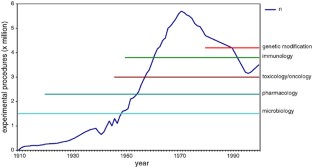
Similar content being viewed by others
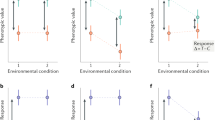
Reproducibility of animal research in light of biological variation
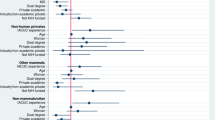
Translational science: a survey of US biomedical researchers’ perspectives and practices

3R measures in facilities for the production of genetically modified rodents
Van Zutphen LFM . History of animal use. In: Van Zutphen LFM, Baumans V, Beynen AC (eds). Principles of Laboratory Animal Science . Elsevier: Amsterdam, 2001, pp 2–5.
Google Scholar
Dennis Jr MB . Welfare issues of genetically modified animals. ILAR J 2002; 43 : 100–109.
Article CAS Google Scholar
Russell WMS, Burch RL . The Principles of Humane Experimental Technique . Methuen: London, 1959, Reprinted by UFAW, 1992: 8 Hamilton Close, South Mimms, Potters Bar, Herts EN6 3QD England.
Download references
Author information
Authors and affiliations.
Department of Laboratory Animal Science, Utrecht University, Utrecht, The Netherlands
Karolinska Institute, Stockholm, Sweden
You can also search for this author in PubMed Google Scholar
Rights and permissions
Reprints and permissions
About this article
Cite this article.
Baumans, V. Use of animals in experimental research: an ethical dilemma?. Gene Ther 11 (Suppl 1), S64–S66 (2004). https://doi.org/10.1038/sj.gt.3302371
Download citation
Published : 29 September 2004
Issue Date : 01 October 2004
DOI : https://doi.org/10.1038/sj.gt.3302371
Share this article
Anyone you share the following link with will be able to read this content:
Sorry, a shareable link is not currently available for this article.
Provided by the Springer Nature SharedIt content-sharing initiative
- animal experiments
This article is cited by
The effect of modification of dna interference on myostatin gene expression in mice.
- Mitra Riasi
- Sina Mozaffari-Jovin
- Ali Javadmanesh
Journal of Genetics (2023)
The small molecule ZY-214-4 may reduce the virulence of Staphylococcus aureus by inhibiting pigment production
BMC Microbiology (2021)
Non-random associations in group housed rats (Rattus norvegicus)
- Leanne Proops
- Camille A. Troisi
- Teresa Romero
Scientific Reports (2021)
Multi-scale generative adversarial network for improved evaluation of cell–cell interactions observed in organ-on-chip experiments
- M. C. Comes
- E. Martinelli
Neural Computing and Applications (2021)
Modeling clear cell renal cell carcinoma and therapeutic implications
- Melissa M. Wolf
- W. Kimryn Rathmell
- Kathryn E. Beckermann
Oncogene (2020)
Quick links
- Explore articles by subject
- Guide to authors
- Editorial policies
Ethical care for research animals
FACTS and MYTHS

You've heard the myths about animals and research science. We'd like to share some of the facts.
Myth: cats, dogs, and primates are the animals most used in research., fact: approximately 95% of the total number of animals needed for medical and scientific inquiry in the u.s. are rodents..
Most of the animals needed for medical and scientific inquiry in the U.S. are rodents (for example, rats and mice), and they are specifically bred for this purpose.
Dogs, cats, and nonhuman primates together account for less than 1% of all animals necessary for medical research. A wide variety of other species make up the remaining 4%, from eels, to armadillos, to zebrafish, to frogs.
Myth: Research animals are abused and mistreated.
Fact: good science and good animal care are inseparable..
If animals are not well treated, the science and knowledge from their studies will not be trustworthy and cannot be replicated, both important hallmarks of the scientific method.
Our researchers are strong supporters of animal welfare, and view their work with animals as a privilege. They are legally, and morally, obligated to ensure the health and well-being of all animals in their care in strict adherence to federal and state regulatory guidelines and humane principles, and to ensure that our animals are involved only in productive and meaningful studies.
Myth: Animal research is scientific fraud, since animals and humans are different.
Fact: there are many similarities between humans and animals..
For example, chimpanzees share more that 99% of DNA with humans, and mice share more than 98%! Animals are susceptible to many of the same health problems as humans – cancer, diabetes, and heart disease, to name a few.
Research with animal species has provided much of what we know about disease progression, care, treatment, and cure. For example, mice have significantly contributed to the advances in the treatment and survival of breast cancer; zebrafish are excellent models for the study of hemophilia; and cats have helped us know more about disorders such as Sudden Infant Death Syndrome (SIDS), sleep apnea, and epilepsy.
Myth: Animal research is no longer necessary because there are non-animal alternatives to animal experiments.
Fact: researchers are committed to the search for alternatives to animal use whenever possible, for ethical, humane, and economic reasons, and a wide-variety of alternative techniques are actively utilized..
Such alternatives include cell-culture techniques, animal or human serum (a derivative of blood), and computer modeling, among others. All together, these alternative research methodologies play an important and growing role in biomedical research. They cannot, however, reproduce the interactions of an intact, whole-living biological system provided by laboratory animals, nor can they reveal potential complications from a drug designed to treat one condition on other organs and systems.
Legally, animal use is a required part of drug development. Current U.S. federal laws and regulations require proof of safety and effectiveness through testing in animal models before any human studies (clinical trials) are allowed to begin. No new drug may be prescribed in the United States without successful completion of human clinical trials and approval by the FDA.
With all the promise and information alternatives to animal-based research offers, it cannot yet fully replace whole-animal models in any comprehensive fashion.
Myth: Animal testing debates argue that animal experiments are needlessly duplicated.
Fact: researchers are committed to preventing any unnecessary duplication of experiments..
The rigorous scientific peer review of research proposals, extensive literature searches, and the study of previous experiments helps researchers prevent duplication.
In addition to the ethical imperative to avoid duplication, there are economic incentives as well. Animal research is expensive and avoiding duplicate experimentation is cost-effective as well as ethically sound. Competition for funding also ensures that redundant experiments are unlikely to be approved, that projects have been evaluated to determine whether animals are necessary, and that the absolute minimum number of animals is used.
Myth: Millions of stolen pets are sold for research.
Fact: animals used for research do not come from random animal dealers who steal dogs and cats for research..
In California, dogs and cats needed for medical research are obtained from specialty laboratory animal breeders, who are registered with the USDA. These specially bred animals are chosen for their genetic make-up, health condition, and breed, something that could not be achieved using animals from pounds or shelters, or from individuals with non-laboratory-bred animals. All dogs and cats must have paperwork that clearly demonstrates their point of origin, to ensure and prove that these animals have never been pets.
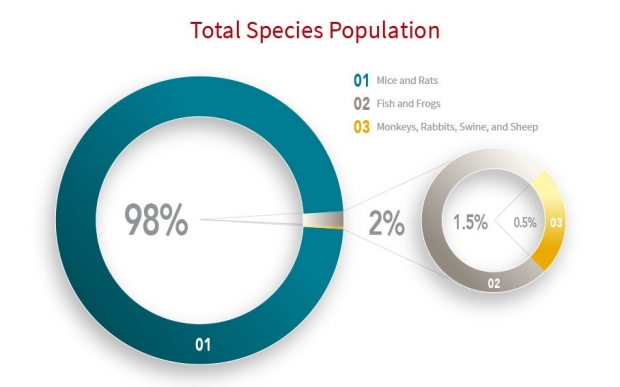
Animal Research species at Stanford. Click for larger view.
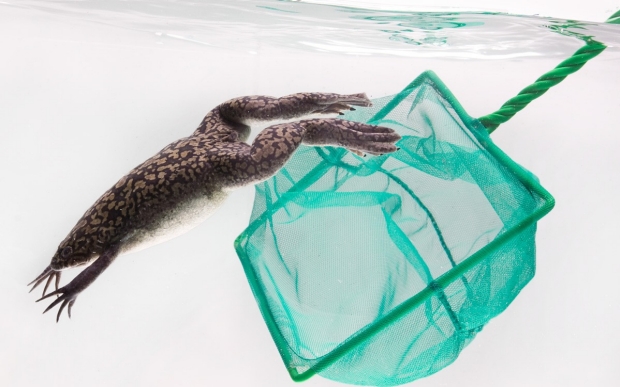
Good animal care = good science.

Mice share 98% of their DNA with humans!

Animal trials are federally mandated.

Alternative techniques are used whenever possible.

Stanford veterinarians caring for research animals.

Regulatory Oversight
Stanford researchers keep to the highest standards of animal care and oversight.
- Learn more about research oversight


Animal Well-Being
The well-being of the animals in our care is of paramount importance at Stanford.
- Are animals treated ethically at Stanford? Learn more

Animal Care and Facilities
All research animals at Stanford live in environments that meet their specific, species-associated needs.
- Learn more about species-specific care
- Back to Previous Menu
- Animals in Laboratories
Animal Testing
Be cruelty-free campaign, biomedical research.
- Animal Protection & Crisis Response
- Abuse/Neglect
- Cruelty in Entertainment
- Disaster Response
- Companion Animals
- Companion Animal Welfare
- Dog and Cat Meat Trade
- Dogfighting
- Horse Protection
- Farm Animals
- Animal Agriculture and Climate Change
- Factory Farming
- Plant-Based Eating
- Human-Wildlife Coexistence
- Rhino and Elephant Protection
- Seal Slaughter
- Shark Finning
- Trophy Hunting
- Wildlife Trade
- Other Ways We Help
- Education and Training
- Legislation/Political Advocacy
- Policy and Treaties
- How You Can Help
- Ways to Give
- Donate Monthly
- Donate Once
- Leave a Gift in Your Will
- Give in Honor of Someone
- Workplace Giving
- Give Stocks or Bonds
- Get Involved
- Take Action
- Our Leadership
- Where We Work
- Financial Information
- News and Resources
- Media Contacts
- Click to share on Facebook (Opens in new window)
- Click to share on Twitter (Opens in new window)
- Click to email a link to a friend (Opens in new window)
About Animal Testing
Humane Society International / Global
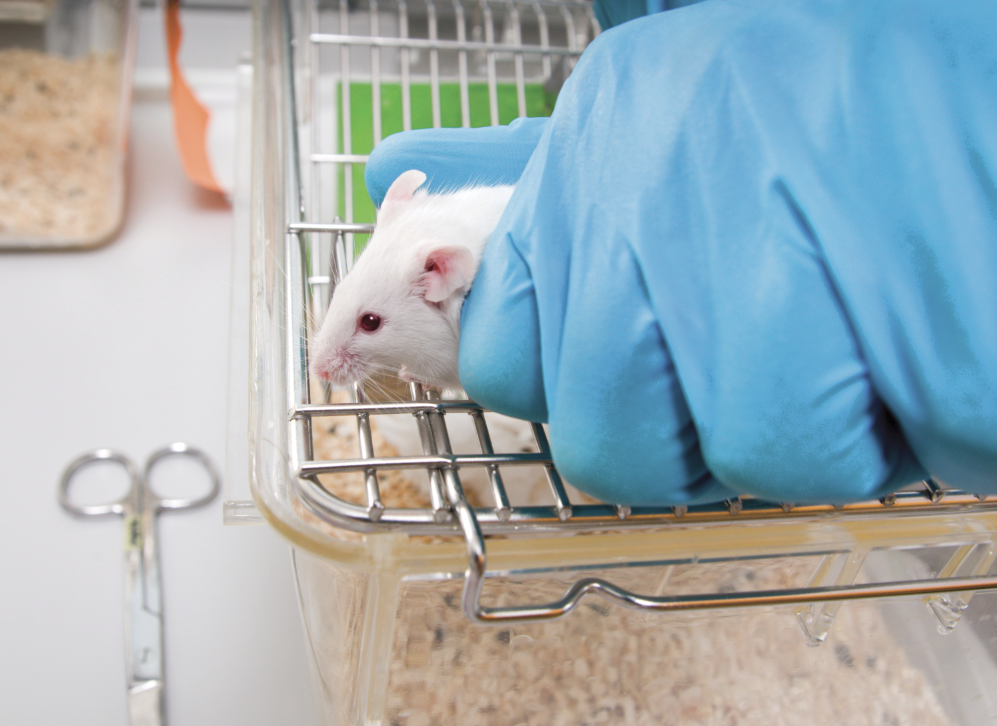
What is animal testing?
The term “animal testing” refers to procedures performed on living animals for purposes of research into basic biology and diseases, assessing the effectiveness of new medicinal products, and testing the human health and/or environmental safety of consumer and industry products such as cosmetics, household cleaners, food additives, pharmaceuticals and industrial/agro-chemicals. All procedures, even those classified as “mild,” have the potential to cause the animals physical as well as psychological distress and suffering. Often the procedures can cause a great deal of suffering. Most animals are killed at the end of an experiment, but some may be re-used in subsequent experiments. Here is a selection of common animal procedures:
- Forced chemical exposure in toxicity testing, which can include oral force-feeding, forced inhalation, skin or injection into the abdomen, muscle, etc.
- Exposure to drugs, chemicals or infectious disease at levels that cause illness, pain and distress, or death
- Genetic manipulation, e.g., addition or “knocking out” of one or more genes
- Ear-notching and tail-clipping for identification
- Short periods of physical restraint for observation or examination
- Prolonged periods of physical restraint
- Food and water deprivation
- Surgical procedures followed by recovery
- Infliction of wounds, burns and other injuries to study healing
- Infliction of pain to study its physiology and treatment
- Behavioural experiments designed to cause distress, e.g., electric shock or forced swimming
- Other manipulations to create “animal models” of human diseases ranging from cancer to stroke to depression
- Killing by carbon dioxide asphyxiation, neck-breaking, decapitation, or other means
What types of animals are used?
Many different species are used around the world, but the most common include mice, fish, rats, rabbits, guinea pigs, hamsters, farm animals, birds, cats, dogs, mini-pigs, and non-human primates (monkeys, and in some countries, chimpanzees). Video: Watch what scientists have to say about alternatives to animal testing .
It is estimated that more than 115 million animals worldwide are used in laboratory experiments every year. But because only a small proportion of countries collect and publish data concerning animal use for testing and research, the precise number is unknown. For example, in the United States, up to 90 percent of the animals used in laboratories (purpose-bred rats, mice and birds, fish, amphibians, reptiles and invertebrates) are excluded from the official statistics, meaning that figures published by the U.S. Department of Agriculture are no doubt a substantial underestimate.
Within the European Union, more than 12 million animals are used each year, with France, Germany and the United Kingdom being the top three animal using countries. British statistics reflect the use of more than 3 million animals each year, but this number does not include animals bred for research but killed as “surplus” without being used for specific experimental procedures. Although these animals still endure the stresses and deprivation of life in the sterile laboratory environment, their lives are not recorded in official statistics. HSI believes that complete transparency about animal use is vital and that all animals bred, used or killed for the research industry should be included in official figures. See some animal use statistics .
What’s wrong with animal testing?
For nearly a century, drug and chemical safety assessments have been based on laboratory testing involving rodents, rabbits, dogs, and other animals. Aside from the ethical issues they pose—inflicting both physical pain as well as psychological distress and suffering on large numbers of sentient creatures—animal tests are time- and resource-intensive, restrictive in the number of substances that can be tested, provide little understanding of how chemicals behave in the body, and in many cases do not correctly predict real-world human reactions. Similarly, health scientists are increasingly questioning the relevance of research aimed at “modelling” human diseases in the laboratory by artificially creating symptoms in other animal species.
Trying to mirror human diseases or toxicity by artificially creating symptoms in mice, dogs or monkeys has major scientific limitations that cannot be overcome. Very often the symptoms and responses to potential treatments seen in other species are dissimilar to those of human patients. As a consequence, nine out of every 10 candidate medicines that appear safe and effective in animal studies fail when given to humans. Drug failures and research that never delivers because of irrelevant animal models not only delay medical progress, but also waste resources and risk the health and safety of volunteers in clinical trials.
What’s the alternative?
If lack of human relevance is the fatal flaw of “animal models,” then a switch to human-relevant research tools is the logical solution. The National Research Council in the United States has expressed its vision of “a not-so-distant future in which virtually all routine toxicity testing would be conducted in human cells or cell lines”, and science leaders around the world have echoed this view.
The sequencing of the human genome and birth of functional genomics, the explosive growth of computer power and computational biology, and high-speed robot automation of cell-based (in vitro) screening systems, to name a few, has sparked a quiet revolution in biology. Together, these innovations have produced new tools and ways of thinking that can help uncover exactly how chemicals and drugs disrupt normal processes in the human body at the level of cells and molecules. From there, scientists can use computers to interpret and integrate this information with data from human and population-level studies. The resulting predictions regarding human safety and risk are potentially more relevant to people in the real world than animal tests.
But that’s just the beginning. The wider field of human health research could benefit from a similar shift in paradigm. Many disease areas have seen little or no progress despite decades of animal research. Some 300 million people currently suffer from asthma, yet only two types of treatment have become available in the last 50 years. More than a thousand potential drugs for stroke have been tested in animals, but only one of these has proved effective in patients. And it’s the same story with many other major human illnesses. A large-scale re-investment in human-based (not mouse or dog or monkey) research aimed at understanding how disruptions of normal human biological functions at the levels of genes, proteins and cell and tissue interactions lead to illness in our species could advance the effective treatment or prevention of many key health-related societal challenges of our time.
Modern non-animal techniques are already reducing and superseding experiments on animals, and in European Union, the “3Rs” principle of replacement, reduction and refinement of animal experiments is a legal requirement. In most other parts of the world there is currently no such legal imperative, leaving scientists free to use animals even where non-animal approaches are available.
If animal testing is so unreliable, why does it continue?
Despite this growing evidence that it is time for a change, effecting that change within a scientific community that has relied for decades on animal models as the “default method” for testing and research takes time and perseverance. Old habits die hard, and globally there is still a lack of knowledge of and expertise in cutting-edge non-animal techniques.
But with HSI’s help, change is happening. We are leading efforts globally to encourage scientists, companies and policy-makers to transition away from animal use in favour of 21st century methods. Our work brings together experts from around the globe to share knowledge and best practice, improving the quality of research by replacing animals in the laboratory.
Are animal experiments needed for medical progress?
It is often argued that because animal experiments have been used for centuries, and medical progress has been made in that time, animal experiments must be necessary. But this is missing the point. History is full of examples of flawed or basic practices and ideas that were once considered state-of-the-art, only to be superseded years later by something far more sophisticated and successful. In the early 1900’s, the Wright brothers’ invention of the airplane was truly innovative for its time, but more than a century later, technology has advanced so much that when compared to the modern jumbo jet those early flying machines seem quaint and even absurd. Those early ideas are part of aviation history, but no-one would seriously argue that they represent the cutting-edge of design or human achievement. So it is with laboratory research. Animal experiments are part of medical history, but history is where they belong. Compared to today’s potential to understand the basis of human disease at cellular and molecular levels, experimenting on live animals seems positively primitive. So if we want better quality medical research, safer more effective pharmaceuticals and cures to human diseases, we need to turn the page in the history books and embrace the new chapter—21st century science.
Independent scientific reviews demonstrate that research using animals correlates very poorly to real human patients. In fact, the data show that animal studies fail to predict real human outcomes in 50 to 99.7 percent of cases. This is mainly because other species seldom naturally suffer from the same diseases as found in humans. Animal experiments rely on often uniquely human conditions being artificially induced in non-human species. While on a superficial level they may share similar symptoms, fundamental differences in genetics, physiology and biochemistry can result in wildly different reactions to both the illness and potential treatments. For some areas of disease research, overreliance on animal models may well have delayed medical progress rather than advanced it. By contrast, many non-animal replacement methods such as cell-based studies, silicon chip biosensors, and computational systems biology models, can provide faster and more human-relevant answers to medical and chemical safety questions that animal experiments cannot match.
“The claim that animal experimentation is essential to medical development is not supported by proper, scientific evidence but by opinion and anecdote. Systematic reviews of its effectiveness don’t support the claims made on its behalf” (Pandora Pound et al. British Medical Journal 328, 514-7, 2004).
You can help: Sign the global pledge to Be Cruelty-Free
Donate to help animals suffering in labs and other cruel situations, discover more.

Imagine a syringe being forced down your throat to inject a chemical into your stomach, or being restrained and forced to breathe sickening vapours for hours. That’s the cruel reality of animal testing for millions of mice, rabbits, dogs and other animals worldwide.
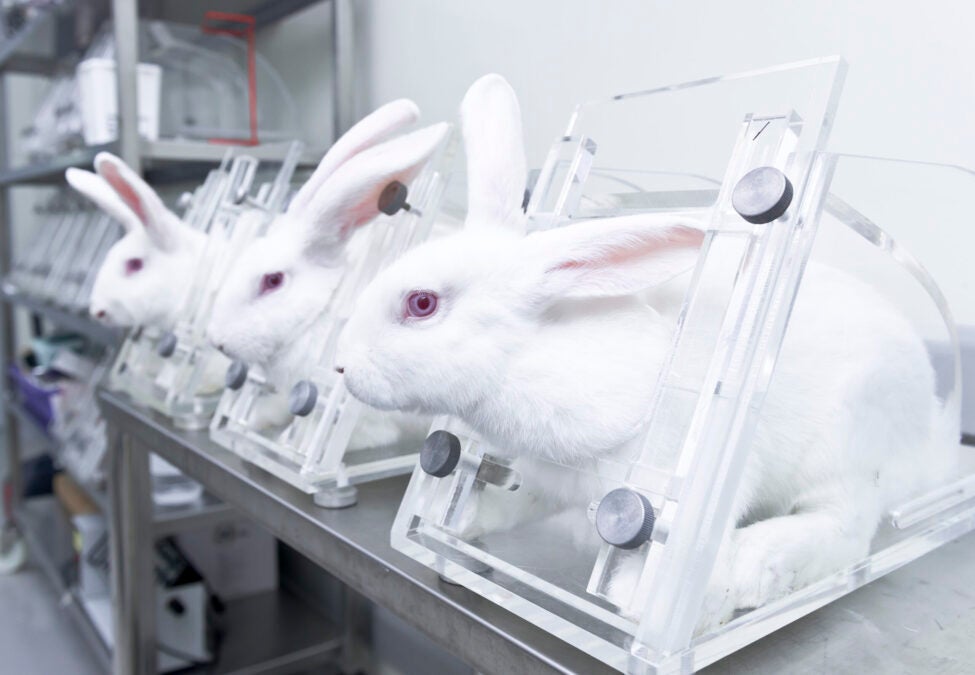
We’re giving the beauty industry a cruelty-free makeover with a wave of animal testing bans supported by hundreds of companies and millions of caring consumers worldwide.
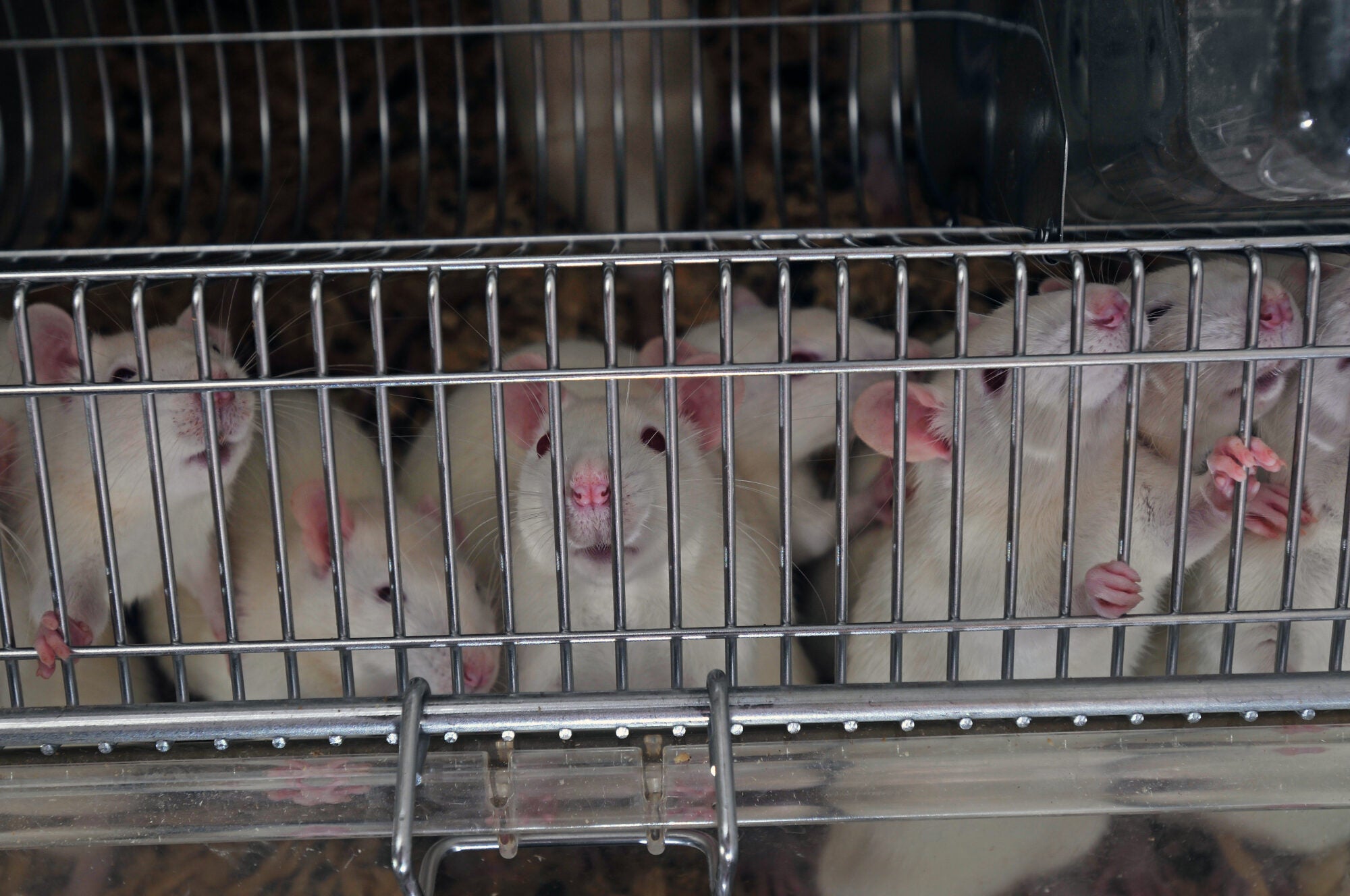
We all dream of the day when cancer is cured and AIDS is eradicated, but is the continued use of mice, monkeys and other animals as experimental “models” of human disease actually holding us back from realizing the promise of 21st century science?
Learn More Button Inserter
- Guide to Clinical Trials Your participation makes a difference
- Clinical Trials in Children Designed to improve kids' health
- Data and Results Sharing our Results
- Integrity and Transparency Building Trust
- Diversity Equity and Representation
- Plain Language Study Results Trial Result Summaries
- Expanded Access & Compassionate Use Possible Treatment Options
- Find a Trial
- Rare Disease Smaller populations but big impact
- Internal Medicine Extending lifespans worldwide
- Inflammation & Immunology Treatment at the molecular level
- Vaccines Preventing the spread of infections
- Oncology The science of optimism
- Anti Infectives Combatting an evolving risk
- Gene Therapy Breakthroughs become treatments
- Medicinal Sciences The next generation of science
- Precision Medicine Developing tailored medicines
- Maternal Immunization Protecting newborns at the start
- mRNA Technology Unleashing the next wave of scientific innovations
- Diseases & Conditions
- Coronavirus Resources
- Product Pipeline
- Research Sites
- Branded vs. Generic Learn the difference
- Biologics & Biosimilars Cures found in nature
- Commitment to Quality Maintaining the highest standards
- Global Supply Strategic manufacturing locations
- Manufacturing Sites Where medicine is made in the U.S.
- Health Literacy Learning to be well
- Treatment Choices Learning about treatment decisions
- Partnering With Patients Helping others by reporting side effects
- Tips for Patients Preventing medication errors
- Reporting Adverse Events
- Counterfeiting Preventing medication errors
- Product Safety
- Product List
- Product Contacts
- PfizerPro for Professionals
- Patient Assistance Programs
- Pfizer Distributors
- Announcements
- Behind the Science Features
- Press Releases
- Media Asset Library
- Updates and Statements
- Partnering News
- Media Contacts
- Executives Our senior-most leadership
- Board Members The people steering our company
- Scientists Our experts making discoveries
- Patient Stories Our patients
- Colleague Stories Our colleagues
- Ethics & Compliance Each of us is responsible
- Responsible Business Breakthroughs that change patients’ lives
- Patient Advocacy & Engagement Putting Patients First
- Global Impact Meeting urgent needs worldwide
- Diversity, Equity, and Inclusion Everyone has something to offer
- Environmental Sustainability Our responsiblity to the environment
- Human Rights Furthering dignity and worth
- Health & Safety
- Intellectual Property The benefits of fair competition
- EHS Governance
- Misinformation
- Grants Support for independent research
- Political Partnership Supporting like-minded organizations
- Working with Healthcare Professionals Collaboration to improve lives
- Prescription Value & Pricing How to lower patient costs
- Privacy Principles Commitment to personal data privacy
- Ready for Cures Improving Access to Medicines
- Transparency in Grants Committed to Disclosure
- Policy Positions
- Investors Overview Information for stockholders
- Why Invest Why to join us in our mission
- Events & Presentations Calendar of upcoming events
- Financial Reports Quarterly reports and more
- Investor News Announcements about our performance
- Stock Information Charts and data
- Shareholder Services Information on stock transactions
- Corporate Governance Overview Gaining insight into our performance
- Board Committees & Charters Defining the corporate structure
- The Pfizer Board Policies Ensuring ethical leadership
- Corporate Governance FAQs Learn more about our approach
- Contact Our Directors Email any of our Directors
- Research and Business Development Partnerships
- Venture Investments
- Business to Business
- Pfizer CentreOne
- Pfizer Ignite
- Submit Your Opportunities
Animals Used in Research
At Pfizer, the animals in our care are key to helping us advance breakthroughs that change patients’ lives. The use of animals in research is currently an essential component of the drug discovery process. Animals help us advance our scientific understanding, serve as models to study disease, help us develop and test potential new medicines and therapies.
Given the present state of scientific knowledge, testing potential new medicines and therapies in animals is critical to their evaluation, and is required by regulatory authorities worldwide to ensure the quality, efficacy and safety of the medicines and therapies we develop. Accordingly, before any potential medicine can be tested in, and subsequently approved for, humans, data from animal models must be submitted to the U.S. Federal Drug Administration (or its equivalent in other countries) to demonstrate its safety and efficacy.
Pfizer is also committed to the use of alternative testing methods whenever possible.
Our Policy is based on the “3Rs”
Replacement of animal with non-animal experiments, such as mathematical models, computer simulations, and in vitro biological systems, wherever appropriate.
Reduction of the number of animals used in each study, and of the number of studies involving animals, to the absolute minimum necessary to obtain valid results and achieve our research objectives.
Refinement of all procedures involving animals to minimize the potential for pain and distress.
There are currently no alternatives acceptable to regulatory authorities that fully replace animal research, but, for as long as it remains necessary to advance safe, effective medical breakthroughs for people, our colleagues will continue to care for our animals with the utmost skill, respect, and concern for the humane and ethical treatment of our research animals.
Learn more about the role animals currently play in the discovery of life-saving medicines
Why is animal research necessary.
Biopharmaceutical companies are ethically and legally obligated to carefully evaluate new medicines before they can be given to patients. Regulatory bodies around the world, including the U.S. Food and Drug Administration, require all potential new medicines undergo safety studies in animals before beginning clinical trials in people.
Animal systems can provide important insights into how a disease works within the body, one of the first steps in the drug discovery and development process. Animals help us advance scientific understanding of our biology, contribute to the development of new medicines and therapies, and protect the safety of people and the environment.
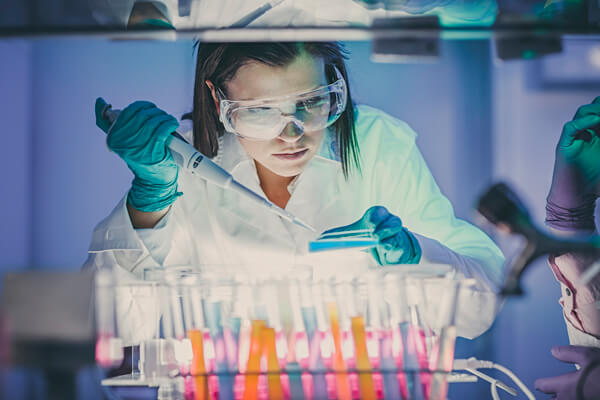
What Kinds of Animals Are Used in Research?
At Pfizer, 99% of the animals in our care are rats and mice. Other species include rabbits, hamsters, guinea pigs, ferrets, dogs, and non-human primates. Our research animals are obtained from approved vendors that are routinely audited by Pfizer for their animal welfare practices and programs of animal care. In addition, we contractually require our breeders to comply with all legal and regulatory requirements and guidelines applicable to their business as well as to Pfizer animal care standards.
How Are the Animals Cared For?
Pfizer is committed to the highest standards of animal care. Our standards meet or exceed relevant local, national, and international regulations. All studies are carefully planned and conducted after review and approval from our Institutional Animal Care and Use Committees (IACUC).
Animal research is highly regulated. Our animal care and use programs are subject to regular unannounced inspections by the United States Department of Agriculture and are found to be in full compliance. In addition, all of our animal research facilities are voluntarily accredited by AAALAC , an international independent third-party accreditation organization.
Our veterinarians, veterinary technicians, and animal care technicians are trained, dedicated professionals, focused on the daily needs, social interaction, and medical attention for our animals, 365 days a year.
All of our research animals are provided with:
- Specially formulated diets, including fresh produce where applicable, that provide the recommended balance of nutrients for each species,
- Uniquely designed environments – including group housing options, bedding preferences, natural play and sheltering habitats, etc. – to better facilitate species-specific behaviors,
- Socialization and enrichment activities, including playrooms, exercise areas, and toys.
For many years, Pfizer has also participated in local adoption programs for animals in good health who are no longer enrolled in research programs.

What Alternatives to Animal Research Exist?
We continuously invest in and pursue the use of animal alternatives in our research activities. In addition to the “3Rs” [described above], Pfizer scientists use simulations and computational tools to replace the need for animal models in some early-stage drug discovery efforts, including drug design, molecule selection, and dose prediction.
When animal studies are necessary, non-invasive imaging techniques may be used include, telemetry (remote recording of physiologic parameters such as body temperature and heart rate), and ultrasound, PET and CT to visualize different organs (i.e. heart, lungs, liver) in the body to help advance scientific discovery. Pfizer also continues to engage in, and lead cross-industry efforts aimed at the development of non-animal testing techniques and predictive informatics that may hold promise, if approved, for the future reduction of animal usage. We work with other pharmaceutical companies, as well as pharmaceutical trade organizations and regulators to increase the recognition and acceptance of alternative models, where they can be used appropriately.
However, at this time, research involving animals remains a critical part of the drug development process and is required by law for almost all products that pharmaceutical companies bring to market.
Learn More About the Role of Animals in the Drug Discovery Process
- Help Animals
- Investigations
- Animal Rights Issues
- Students Opposing Speciesism (SOS)
- Join the Action Team
- Monthly Giving
- Your Legacy For Animals
- PETA Vanguard Society
- ‘In Honor of’ and Memorial Gifts
- Membership Services
- More Ways to Support PETA
- Report Cruelty to Animals
- Urgent Alerts
- Our Campaigns
- Action Team
- Activist Guide
- Get Active Online
- Leaflets & Stickers
- Adoptable Animals
- Rescue Stories
- Recent Investigations
- Investigations & Rescue Fund
Animals Used for Experimentation
- Entertainment
- Companion Animals
- Personal Care & Fashion
- Food & Health
- Humane Home
- Animal Companions
- Cruelty-Free Database
- PETA Shopping Guide
- PETA Approved Vegan
- PETA Presents
- Work at PETA
- PETA Global
- Vanguard Society
- More Ways to Support
- Gifts in Wills
Right now, millions of mice, rats, rabbits, primates, cats, dogs, and other animals are locked inside cages in laboratories across the country. They languish in pain, ache with loneliness, and are deprived of everything that’s natural and important to them. All they can do is sit and wait in fear of the next terrifying and painful procedure that will be performed on them. A lack of environmental enrichment and the stress of their living situations cause some animals to develop neurotic behaviors, such as incessantly spinning in circles, rocking back and forth, pulling out their own fur, and even biting themselves. After enduring lives of pain, loneliness, and terror, almost all of them will be killed.
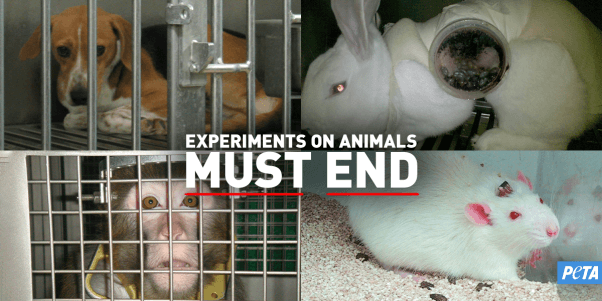
How PETA Helps Animals in Laboratories
Since PETA’s inception and the landmark Silver Spring monkeys case, we’ve been at the forefront of exposing and ending experiments on animals. Our scientists, campaigners, researchers, and other dedicated staff work hard to persuade universities, hospitals, contract laboratories , other companies , and government agencies to abandon animal tests and embrace modern, non-animal methods.
Two teams lead PETA’s efforts to end tests on animals. Our Laboratory Investigations Department focuses on ending the use of animals in experiments not required by law, and our Regulatory Toxicology Department focuses on replacing the use of animals in tests required by law with human-relevant, animal-free toxicity testing approaches. With help from supporters like you, these teams and other hardworking staff at PETA win numerous victories for animals imprisoned in laboratories every year. Here’s how they do it:
- Promoting PETA’s Research Modernization Deal , the first comprehensive, science-backed plan to phase out tests on animals
- Conducting groundbreaking eyewitness investigations and colorful advocacy campaigns to shut down laboratories and areas of animal experimentation
- Filing groundbreaking lawsuits to challenge public funding of wasteful, cruel animal experiments
- Working with members of Congress to enact laws to replace animals in laboratories
- Persuading government agencies to stop conducting and requiring experiments on animals
- Encouraging pharmaceutical, chemical , and consumer product companies to replace tests on animals with more effective, non-animal methods
- Ending the use of animals in experiments at colleges and universities
- Helping students and teachers end animal dissection in the classroom
- Developing and funding humane non-animal research methods
- Publishing scientific papers on reliable non-animal test methods and presenting them at scientific conferences
- Hosting free workshops and online seminars to share information about animal-free toxicity testing methods
- Urging health charities not to invest in dead-end tests on animals
How Animals Are Exploited in Laboratories
More than 110 million animals suffer and die in the U.S. every year in cruel chemical, drug, food, and cosmetics tests. They also experience this fate in medical training exercises , curiosity-driven experiments at universities , classroom biology experiments , and dissection even though modern, non-animal methods have repeatedly been shown to have more educational value, save teachers time, and save schools money. Exact numbers aren’t available, because mice, rats, birds, and cold-blooded animals—who make up more than 99% of animals used in experiments—aren’t covered by even the minimal protections of the federal Animal Welfare Act and therefore go uncounted.
Examples of chemical and toxicity tests on animals include forcing mice and rats to inhale toxic fumes, force-feeding dogs chemicals, and applying corrosive chemicals into rabbits’ sensitive eyes. Even if a product harms animals, it can still be marketed to consumers. Conversely, just because a product was shown to be safe in animals doesn’t guarantee that it will be safe to use in humans.
Much product testing conducted on animals today isn’t required by law. In fact, a number of countries have implemented bans on the testing of certain types of consumer goods on animals, such as the cosmetics testing bans in India, Israel, New Zealand, Norway, and elsewhere.
Meanwhile, at universities and other institutions, experimenters inflict suffering on and kill animals for little more than curiosity’s sake—even though the vast majority of their findings fail to advance human health . They tear baby monkeys away from their mothers , sew kittens’ eyes shut , mutilate owls’ brains , puncture the intestines of mice so that feces leak into their stomachs , and terrorize songbirds with the sounds of predators . At the end of experiments like these—which consume billions in taxpayer funds and charitable donations each year—almost all the animals are killed.
Animal Experiments Throughout History: A Century of Suffering
PETA created an interactive timeline, “ Without Consent ,” featuring almost 200 stories of animal experiments from the past century to open people’s eyes to the long history of suffering inflicted on nonconsenting animals in laboratories and to challenge them to rethink this exploitation. Visit “ Without Consent ” to learn more about harrowing animal experiments throughout history and how you can help create a better future for living, feeling beings.
Advancing Science Without Suffering: Animal-Free Testing
Testing on animals has been a spectacular failure that has resulted in the loss of trillions of dollars and has cost the lives of innumerable humans and other animals. Experiments on one species frequently fail to predict results in another. Even the National Institutes of Health, the world’s largest funder of biomedical research, acknowledges that 95% of all drugs that are shown to be safe and effective in animal tests fail in human trials.

Technologically advanced non-animal research methods —such as those using human cells, computational models, or clinical studies—can be used in place of animal testing. These methods are more humane, have the potential to be faster, and are more relevant to humans.
Scientists in PETA’s Science Advancement & Outreach division , a part of the Laboratory Investigations Department, have developed a roadmap to phase out failing tests on animals with sophisticated, animal-free methods. Their Research Modernization Deal has gained the support of scientists, medical doctors, members of Congress, and thousands of others who care about ethical and effective science.
How You Can Help Animals Used in Experiments
Each of us can help prevent the suffering and deaths of animals in laboratories. Here are a few easy ways to get started:
- Sign up for PETA’s Action Team to be alerted when protests are taking place in your area.
- Urge your members of Congress to support PETA’s Research Modernization Deal .
- Search PETA’s Beauty Without Bunnies database to ensure that you’re buying only cruelty-free products.
- Donate only to charities that don’t experiment on animals .
- Request alternatives to animal dissection at your school.
- Call on your alma mater to stop experimenting on animals.
- Share information about animal experimentation issues with your friends and family—and invite them to join you in speaking up for animals.
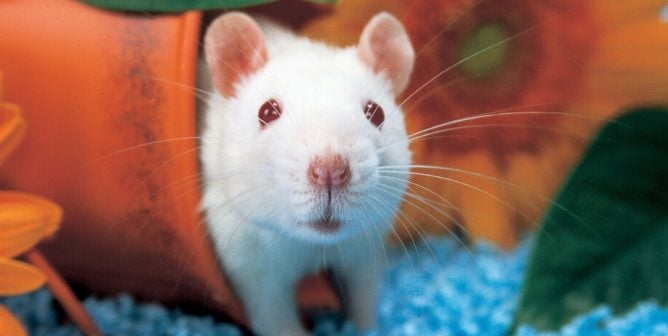
Popular Resources

PETA’s Beauty Without Bunnies program is the ultimate resource for conscientious shoppers, making the quest for cruelty-free products as easy as pie.

Stand up for your rights in five easy steps!

Take PETA’s Shopping Guide along with you next time you head to the store! Our handy guide will help you find humane products at a glance.

Sign the pledge and joining the thousands of caring consumers who refuse to purchase products from corporations that abuse animals.
By submitting this form, you’re acknowledging that you have read and agree to our privacy policy and agree to receive e-mails from us.

“Almost all of us grew up eating meat, wearing leather, and going to circuses and zoos. We never considered the impact of these actions on the animals involved. For whatever reason, you are now asking the question: Why should animals have rights? ”
— Ingrid E. Newkirk, PETA President and co-author of Animalkind
Text CRAZY to 73822 to take action for chimpanzees suffering in human homes & roadside zoos! Then watch Chimp Crazy, HBO’s new docuseries to learn more.
Terms for automated texts/calls from PETA: http://peta.vg/txt . Text STOP to end, HELP for more info. Msg/data rates may apply. U.S. only.
Warning: The NCBI web site requires JavaScript to function. more...
An official website of the United States government
The .gov means it's official. Federal government websites often end in .gov or .mil. Before sharing sensitive information, make sure you're on a federal government site.
The site is secure. The https:// ensures that you are connecting to the official website and that any information you provide is encrypted and transmitted securely.
- Publications
- Account settings
- Browse Titles
NCBI Bookshelf. A service of the National Library of Medicine, National Institutes of Health.
National Research Council (US) and Institute of Medicine (US) Committee on the Use of Laboratory Animals in Biomedical and Behavioral Research. Use of Laboratory Animals in Biomedical and Behavioral Research. Washington (DC): National Academies Press (US); 1988.
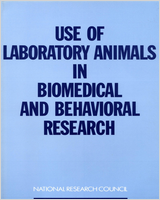
Use of Laboratory Animals in Biomedical and Behavioral Research.
- Hardcopy Version at National Academies Press
3 Benefits Derived from the Use of Animals
Animal studies have been an essential component of every field of medical research and have been crucial for the acquisition of basic knowledge in biology. In this chapter a few of the contributions of such studies in biomedical and behavioral research will be chronicled. These descriptions should be viewed within the context of the vast improvements in human health and understanding that have occurred in the past 150 years. For example, since 1900 the average life expectancy in the United States has increased by 25 years (U.S. National Center for Health Statistics, 1988). This remarkable increase cannot be attributed solely to animal research, as much of it is the result of improved hygiene and nutrition, but animal research has clearly been an important contributor to improved human health.
Despite the many advances and the projected results that will come through the use of animals, some individuals question the value of using animal models to study human disease, contending that the knowledge thus gained is insufficiently applicable to humans. Although experiments performed on humans would provide the most relevant information (and are used in clinical research conducted on humans when appropriate), it is not possible by commonly accepted ethical and moral standards or by law to perform most experiments on humans initially. It is true that not every experiment using animals yields immediate and practical results, but the advances that will be described in this chapter provide evidence that this means of research has contributed enormously to the well-being of humankind.
As a result of the acquisition of information and the development of techniques achieved through the use of animals, poliomyelitis is no longer a major threat to health in the United States. The number of cases of paralytic polio in the United States has declined as a result of vaccinations from 58,000 in 1952 to only 4 in 1984 (Office of Technology Assessment, 1986). Unfortunately, polio is still a major threat to health where the vaccine is not used. Indeed, in a number of African, Asian, and South American countries, the incidence of the disease has been rising, despite the availability of the vaccine (Cockburn and Drozdov, 1970). An estimated 500,000 cases occur around the world each year (Salk, 1983).
The use of rhesus monkeys for the study of polio began when Landsteiner and Popper (1909) showed that injection of spinal cord material from patients dying of polio caused paralysis in the animals. Flexner and Lewis (1909) promptly confirmed this result. To learn how to immunize monkeys to protect them against infection, researchers first used live virus, then formalin-inactivated virus from infected brain suspensions, and eventually modified live virus. A major breakthrough occurred when Enders, Weller, and Robbins (1949) showed that the virus could be propagated in cultured cells of non-neural origin. That set the stage for mass production of viruses that could be made into formalin-inactivated Salk vaccine or the modified live-virus Sabin vaccine (Salk, 1983).
Although the use of monkeys in polio research has decreased considerably, they are still essential to the production of both live and killed polio vaccines, which are routinely produced in monkey kidney cell cultures. The live vaccine is tested for neurovirulence in monkeys, and the killed vaccine is routinely tested for safety in monkeys.
- Acquired Immune Deficiency Syndrome
The recent emergence of acquired immune deficiency syndrome (AIDS) as a major health threat exemplifies not only the unpredictability of research needs, but also the criticality of animals in research. The similarity of simian AIDS, identified in rhesus monkeys at two primate centers, to human AIDS has allowed the disease in monkeys to serve as a model for the human disease. In monkeys, the virus that causes the disease has been isolated, infectibility studies have been conducted, and some experiments have provided preliminary indications of the possibility of vaccine development. This animal model might prove useful for testing the efficacy and safety of vaccines and therapeutic agents developed to prevent or treat the human disease (Institute of Medicine, 1986).
Recently, a new virus called feline T-lymphotropic lentivirus has been discovered. It resembles morphologically the human immunodeficiency virus (HIV) that causes AIDS, although differing antigenically, and causes a disease naturally in cats similar to AIDS. Thus, infected cats might prove useful as animal models for the study of certain aspects of human AIDS (Pedersen et al., 1987).
- Transplantation
The transplantation of skin, corneas, and various internal organs could not have become a safe and standard procedure without the knowledge of the biology of transplantation immunology acquired through the use of experimental animals. Some 30,000 Americans now alive have transplanted kidneys, and others survive with transplanted hearts and livers or retain their sight because of corneal transplants.
The treatment of burn victims was of particular importance to the British during World War II, and British biologist P. B. Medawar (1944) undertook to find relief for them through the transplantation of skin. For one of his models, he used freemartin cattle. A freemartin is a sexually maldeveloped female calf that is born as a twin of a normal male calf; male hormones that reach it through placental vessels usually make it sterile (Lillie, 1917). Experimentation showed that skin and other tissues could be transplanted with good, lasting success between the male and freemartin twins at any stage in their lives (Anderson et al., 1961). They were "tolerant" of each other's tissues because of prenatal exposure to each other's tissue antigens. Medawar and his colleagues sought to induce such tolerance in newborn mice. When newborns received skin transplants or received bone marrow from unrelated animals, they became forever "tolerant" of the new tissue (Brent et al., 1976). That discovery signaled a new era in immunology, with wide ramifications for health and the treatment of disease not only in humans, but also in animals.
Through a systematic study of the surface immune markers of specially bred strains of mice, Snell and Benacerraf provided the basis for much of the understanding that has led to the success of organ transplantation (Benacerraf, 1981).
In the past, young women with chronic pyelonephritis, patients with genetic polycystic disease, and people suffering from the aftermath of streptococcal infections were all vulnerable to chronic renal failure and death. Those people benefited from the invention of "artificial kidneys," which periodically washed blood and removed poisonous substances from it. The recipients of the benefit, however, had to undergo frequent, laborious, and uncomfortable procedures and had to rely on hospitals and mechanical devices.
The first extensive work with renal transplantation was reported in 1955 (Hume et al., 1955). At first, transplanted kidneys were rejected unless they were exchanged between identical twins. However, studies in dogs showed that administration of the drug 6-mercaptopurine after transplantation would prolong the survival of a transplanted organ from an unrelated person. This use of immunosuppressants ushered in the modern era of transplantation (Starzl and Holmes, 1964). These compounds, having been studied first in animals and proved to be effective, are now used in human transplant recipients.
The study of tissue antigens proceeded at the same time as transplantation work, first in mice and then in humans. Inbred (isogeneic) strains of mice had been created by repeated brother-sister matings. Ultimately, these strains became genetically identical, and the exchange of tissues and organs became possible. In the study of minor genetic differences between such strains, it became clear that some genes specify the cell-surface structures responsible for tissue recognition and rejection. "Transplantation antigens" can now be identified by tissue typing, and the most appropriate donors can be chosen for transplantation in both humans and animals.
A second revolution in transplantation was ushered in by the development of cyclosporin. This immunosuppressive agent was first used successfully in humans in 1983, after five years of toxicity and efficacy testing in mice, rats, and other animals. Since it became available for heart transplantation, survival after transplantation has improved significantly (Kupiec-Weglinski et al., 1984). Further progress is now occurring with monoclonal antibodies that seem to immobilize the cell-surface markers responsible for recognition and rejection. The hope is that such monoclonal antibodies, which have been developed and maintained in animals, will make it unnecessary to resort to complete immunosuppression of a transplant recipient. This would reduce the occurrence of infection and increase the rates of survival of transplanted organs.
- Cardiovascular-Renal Systems
Dogs have traditionally been used in cardiovascular-renal studies because of their relatively large size, which facilitates experimental procedures. For example, an early model of hypertension was produced by partially occluding the renal artery in dogs. Studies of renal function that use clearance techniques in unanesthetized animals are most often done in dogs. In the last two decades, however, some mutant rats have proved exceedingly valuable as animal models of human disease. The Brattleboro rat is an excellent example. It has diabetes insipidus and must drink 70 percent of its body weight in water each day. It cannot produce vasopressin, a hormone that plays an essential role in the kidneys' ability to regulate water excretion and blood pressure. Research on the Brattleboro rat has greatly increased our understanding of vasopressin's role in kidney and cardiovascular function, and that understanding might lead to the development of better drugs (and drugs with fewer side effects) for the treatment of clinical disorders (Sokol and Valtin, 1982).
The development of open-heart surgery is but one of many examples of the value of using laboratory animals. Working with cats and dogs, Gibbon built the forerunner of the present-day heart-lung machine (Deaton, 1974), which makes open-heart surgery possible. His research in the early 1930s included clamping off more and more of an animal's vasculature and detouring its blood through the heart-lung machine. The machine was further improved by the incorporation of a roller pump developed by DeBakey (DeBakey and Henly, 1961), which allowed the entire circulation to be shunted through the machine, which added oxygen to the animal's blood. The pump was first used and perfected in the animal laboratory and is now a standard, essential component of the heart-lung machine. As a result of these developments, more than 80 percent of infants born with congenital cardiac abnormalities now can be treated surgically and can lead normal lives.
Replacement of heart valves and segments of large arteries in the treatment of valvular heart disease was made feasible by dog studies done in the late 1940s and early 1950s (Gay, 1984). Before diseased heart valves could be replaced in patients, scientists had to study their design and use in animals. As with so many other drugs and operations, physicians and surgeons would not consider applying them to patients until they had proved safe and effective in animals, nor would the public accept them until their safety was proved. Each decade since then has seen improvements in the design, installation, and performance of these valves and other prosthetic devices. Because the ideal valve has not yet been developed, research is still in progress in many laboratories to further improve its capacities.
- Nervous System
The human brain is a structure of extraordinary complexity. Each of its 200 billion neurons (nerve cells) makes a few thousand to several hundred thousand connections with other neurons, muscles, or glands. Neurons use large amounts of metabolic energy to carry out a host of functions: the generation and conduction of impulses; the synthesis, transport, secretion, and uptake of transmitters; and the modification of structure and synaptic efficacy in response to activity and environmental perturbations (Kandel and Schwartz, 1985).
Many basic aspects of neuronal development can be studied in cell and tissue cultures, in brain slices, and in simple invertebrate neuronal systems. Computer simulations and noninvasive human studies can also provide important data on fundamental mechanisms of learning and memory. Yet there is no adequate substitute for animal studies in attempts to understand the complex behavioral and cognitive functions of the brain in health and disease.
Movement and Function
Our understanding of the nervous system and approaches to rational therapy of its disorders could not have come about without animal studies initiated by the physiologist Charles Sherrington (Eccles and Gibson, 1979). His studies on reflex mechanisms of the spinal cord in cats were continued by Eccles (1957), who described how excitatory and inhibitory processes work in the central nervous system. Today, neurosurgeons can remove some brain tumors with minimal damage to the motor system in part because scientists such as Sherrington discovered that localized electrical stimulation of the exposed brain of the dog could elicit discrete movements of the limbs.
Neurologists and neurosurgeons now examine electrical signals from the brain to diagnose and treat epilepsy, study levels of consciousness, localize brain tumors, diagnose multiple sclerosis, and study learning disabilities in children. Moreover, the applications of such essential tools for diagnosis and therapy as computed axial tomographic (CAT) scans and magnetic resonance imaging (MRI) were developed with research animals (Kandel and Schwartz, 1985).
The study of the nervous system and behavior is one of the major frontiers of modern science. A good deal is known about the anatomy and physiology of the brain and nervous system, but much remains to be learned about it as an organized assemblage of neurons and about how it is affected by environmental stimulation. The following examples provide an idea of how animals are used in studies of such subjects.
Postnatal Development of the Visual Cortex and the Influence of Environment
Hubel and Wiesel shared the Nobel Prize in 1981 for their studies of vision in cats and monkeys, including the development of visual functions in young animals (Barlow, 1982). The visual cortex of monkeys is not fully developed at birth; nerve cells are still growing and making connections with other nerve cells. In this process, normal development depends on visual stimulation during a critical period in early postnatal life.
As in humans, each eye of a monkey sees a slightly different view of the same object; normal binocular vision gives the impression of depth. If early in postnatal life one eye is occluded, the nerve cells for that eye in the visual cortex do not develop normally. Most of the nerve cells become responsive only to the open eye, as shown in recordings from cells of the visual cortex of anesthetized animals. In normal development, the visual cortex consists of alternating bands of reactive neurons from the right and left eyes; but in a monkey with an occluded eye, the regular alternation is weakened, and most neurons react only to the normal eye. These anatomical and physiological changes are the basis of blindness in the occluded eye.
Children with congenital cataracts or clouding of the ocular media for other reasons demonstrate a similar dependence of human vision on visual stimulation. Testing after restoration of normal vision has shown that the acuity of the previously occluded eye is reduced; the earlier in life the eye was occluded, the greater the degree of deficit. Animal experiments have also shown that correction of strabismus (squint) by surgery should be performed early in, or certainly before the end of, the critical period of eye-brain development to ensure normal vision (Wiesel, 1982).
The close correlation between the effects of visual deprivation observed in animals and the effects observed in the clinic suggests that they are based on similar physiological mechanisms. This correlation has been helpful in developing appropriate measures of prevention and treatment of neural eye disorders.
Another subject of behavioral research is memory. An estimated 5 percent of people over the age of 65 have severe limitations or even failures of memory and cognition; another 10 percent of the people over 65 have mild to moderate cognitive problems (Coyle et al., 1985). Specific conditions, such as Korsakoff's syndrome and Alzheimer's disease, affect mental functions and can cause extreme memory loss. Research on animals is improving the understanding of the mechanisms of such losses. In turn, this increased understanding has led to the discovery of some drugs that show promise of counteracting the losses. Most of the knowledge about the neurotransmitters involved in these diseases has also been derived from studies of the brains and nervous systems of animals.
Primates are phylogenetically closer to humans than are other mammals. Their behavioral capabilities are in keeping with the greater development and complexity of their brains. Primates also have age-related decrements in memory function. Generally, memory impairment with advancing age first appears as a failure of immediate memory, the recall of events that have just occurred. Transmitter chemicals of the α-adrenergic class, like clonidine, were first found to improve memory performance in macaques and aged rodents. Clonidine has now also proved effective in improving the memory of patients with Korsakoff's syndrome. Those findings suggest a new approach to the treatment of patients with memory disorders, and they have provided a new option for clinical trials with patients suffering from Alzheimer's disease (Arnsten and Goldman-Rakic, 1985).
Pain is a common symptom of disease in humans and animals. It is important that medical science develop more effective methods of pain management than are now available. Much pharmacological research has focused on the production of drugs with potent analgesic properties, and much research on pain—particularly that concerned with analgesics, acupuncture efficacy, hypnosis, and so on—has been carried out on human subjects for over a century. Research using animals is necessary, however, if unsolved problems are to be adequately addressed.
Although many experiments that study pain must involve pain for the animal, researchers have developed methods that are as humane as possible within the context of the experiment. For example, the slightest reflex movement of the tail of a rat or mouse is objective evidence that a noxious stimulus applied to the skin of the tail has attained threshold intensity. Reflex behavior, such as the tail-flick, is a useful index of the comparative effectiveness of analgesics, as well as of the effects of manipulating chemical messengers in the central pain pathways (Willis, 1985).
The understanding of intrinsic brain mechanisms of pain and its modification will require the use of modern techniques for cell marking and pathway tracing, immunocytochemical and microphysiological methods, and sophisticated behavioral studies. Paradoxically, many investigations of pain can be explored in anesthetized animals. Thanks to psychophysical studies in humans that were replicated in animals, neuroscientists have been able to trace the nerve fibers from skin, muscle, and internal organs that are specific carriers of ''pain signals.'' With such a powerful handle on the input end of the pain system, the passage and transformation of pain signals can be explored in complex neuronal organizations in anesthetized animals. It is also possible to study the central systems that control the passage of pain signals to higher levels of the central nervous system. Finally, isolation and identification of the transmitters, structure, and other components of the neurochemical machinery of the brain involved in pain perception and its modification can be elucidated (Willis, 1985).
Increasing recognition that behavioral factors play a significant role in many current health problems—for example, drugs and alcohol abuse, eating disorders, effects of stress, cardiovascular disease, and mental and psychiatric ailments—has led to the development of animal models for experimental and biological analysis as part of the emerging field of behavioral medicine (Hamburg et al., 1982).
- Other Benefits for Humans
The preceding examples provide a sampling of the contributions that research using animals has made to the improvement of human health and the acquisition of knowledge. Many others could be cited—for example, the development of medicinals such as the sulfonamides (Hubbard, 1976); the development of life-support systems for premature infants (Coalson et al., 1982; deLemos et al., 1985; Escobedo et al., 1982); and the increase in understanding of learning (Miller, 1985; Pavlov, 1927; Skinner, 1938; Thorndike, 1898), nonlinguistic communication (Gardner and Gardner, 1969; Romski et al., 1984), drug abuse (Deneau et al., 1969; National Institute of Drug Abuse, 1984; Seevers, 1968), and nervous system regeneration. Many examples of such benefits are also chronicled in publications such as those by Gay (1986), Leader and Stark (1987), and Paton (1984).
- Benefits for Animals
One might have the impression that animal research is conducted only with the aim of alleviating human suffering. The conduct of extensive research in veterinary schools and other institutions indicates that that is not the case. Most research on domestic farm animals is undertaken to increase the productivity and quality of animal products. Research is also undertaken to reduce the suffering and increase the overall well-being of animals, particularly companion animals. Examples include current research on Potomac fever in horses, the development of ivermectin to eradicate parasitic diseases in a variety of animals, and the development of vaccines for feline leukemia virus and canine parvovirus.
Research aimed at human illnesses has also had immeasurable benefits for animals. A host of immunizations and antibiotics have proven applicable to the therapy of animal diseases (Paton, 1984). Kidney transplantation, cardiovascular treatments, chemotherapeutics, and narcotics are widely applicable, as are the insights gained from genetic research (Gorman, 1988).
One example of the benefits of biomedical research for animals can be found in the propagation of endangered species. The ability to transfer embryos, eliminate parasitism, treat illnesses, and use anesthetic advances has improved the health and survival of many species. The knowledge gained from genetic studies has allowed appropriate management of species that are endangered or have disappeared in the wild. For example, the ability to identify the sex of birds has been essential in the management of the whooping crane and the California condor. Research into obstacles to successful breeding in captivity has markedly reduced the need for importation of many species, especially monkeys. For example, among nonhuman primate species used in research, there were 7,908 births in 1984 in the United States, compared with 2,198 in 1973 (Johnsen and Whitehair, 1986).
Animal research has resulted in enormous benefits for humans and animals. The searching and systematic methods of scientific inquiry have greatly reduced the incidence of human disease and have substantially increased life expectancy. Those results have come largely through experimental methods based in part on the use of animals, as illustrated by the many examples cited in this chapter.
At the same time, much obviously remains to be learned. Further studies in such areas as cancer, heart disease, diabetes, AIDS, dementias, and the development of vaccines and chemotherapeutic agents will continue to require the use of animals.
- Cite this Page National Research Council (US) and Institute of Medicine (US) Committee on the Use of Laboratory Animals in Biomedical and Behavioral Research. Use of Laboratory Animals in Biomedical and Behavioral Research. Washington (DC): National Academies Press (US); 1988. 3, Benefits Derived from the Use of Animals.
- PDF version of this title (664K)
In this Page
Recent activity.
- Benefits Derived from the Use of Animals - Use of Laboratory Animals in Biomedic... Benefits Derived from the Use of Animals - Use of Laboratory Animals in Biomedical and Behavioral Research
Your browsing activity is empty.
Activity recording is turned off.
Turn recording back on
Connect with NLM
National Library of Medicine 8600 Rockville Pike Bethesda, MD 20894
Web Policies FOIA HHS Vulnerability Disclosure
Help Accessibility Careers

Suggested Searches
- Climate Change
- Expedition 64
- Mars perseverance
- SpaceX Crew-2
- International Space Station
- View All Topics A-Z
Humans in Space
Earth & climate, the solar system, the universe, aeronautics, learning resources, news & events.
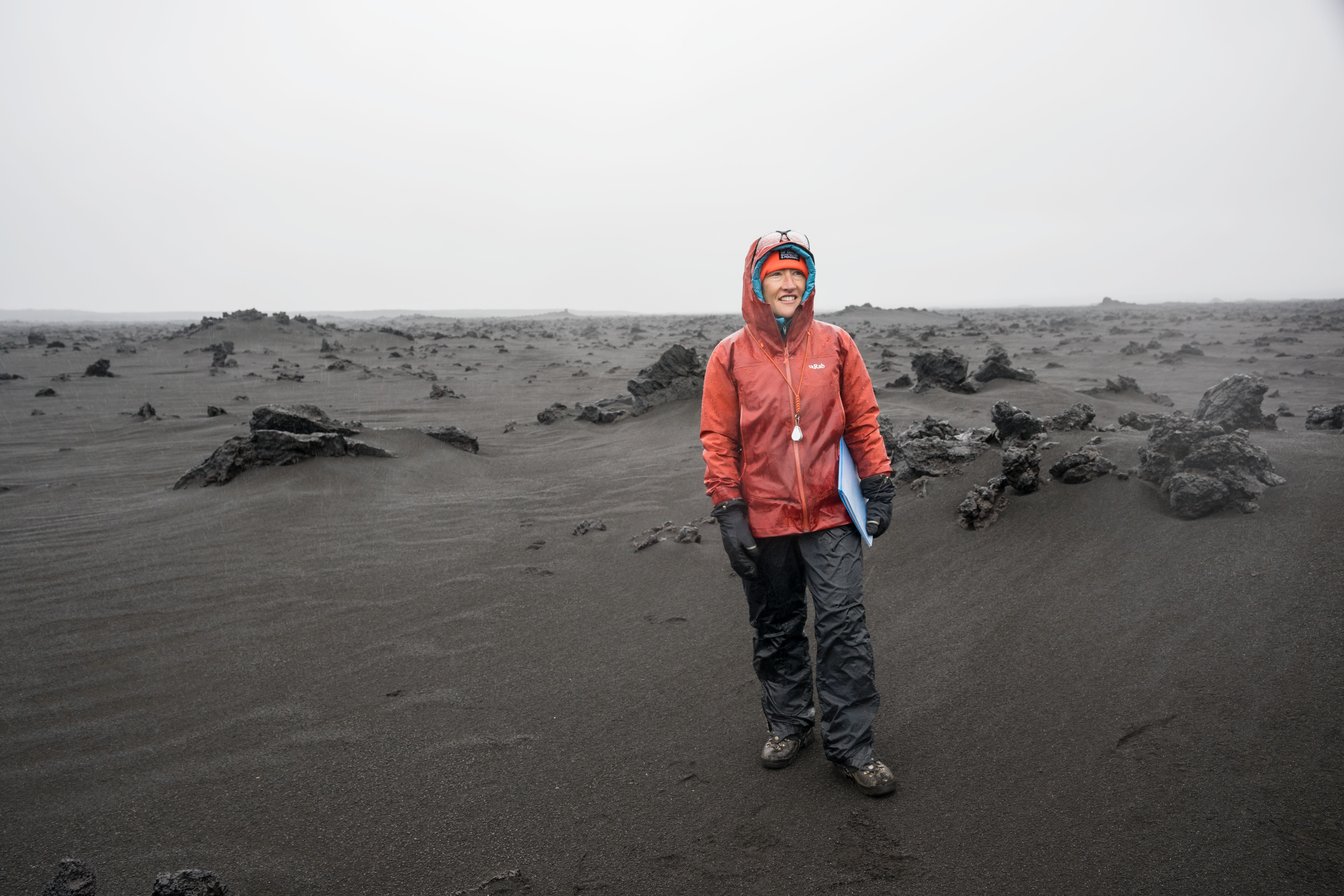
NASA’s Artemis II Crew Uses Iceland Terrain for Lunar Training

NASA’s Webb Peers into the Extreme Outer Galaxy

What’s Up: September 2024 Skywatching Tips from NASA
- Search All NASA Missions
- A to Z List of Missions
- Upcoming Launches and Landings
- Spaceships and Rockets
- Communicating with Missions
- James Webb Space Telescope
- Hubble Space Telescope
- Why Go to Space
- Commercial Space
- Destinations
Living in Space
- Explore Earth Science
- Earth, Our Planet
- Earth Science in Action
- Earth Multimedia
- Earth Science Researchers
- Pluto & Dwarf Planets
- Asteroids, Comets & Meteors
- The Kuiper Belt
- The Oort Cloud
- Skywatching
- The Search for Life in the Universe
- Black Holes
- The Big Bang
- Dark Energy & Dark Matter
- Earth Science
- Planetary Science
- Astrophysics & Space Science
- The Sun & Heliophysics
- Biological & Physical Sciences
- Lunar Science
- Citizen Science
- Astromaterials
- Aeronautics Research
- Human Space Travel Research
- Science in the Air
- NASA Aircraft
- Flight Innovation
- Supersonic Flight
- Air Traffic Solutions
- Green Aviation Tech
- Drones & You
- Technology Transfer & Spinoffs
- Space Travel Technology
- Technology Living in Space
- Manufacturing and Materials
- Science Instruments
- For Kids and Students
- For Educators
- For Colleges and Universities
- For Professionals
- Science for Everyone
- Requests for Exhibits, Artifacts, or Speakers
- STEM Engagement at NASA
- NASA's Impacts
- Centers and Facilities
- Directorates
- Organizations
- People of NASA
- Internships
- Our History
- Doing Business with NASA
- Get Involved
NASA en Español
- Aeronáutica
- Ciencias Terrestres
- Sistema Solar
- All NASA News
- Video Series on NASA+
- Newsletters
- Social Media
- Media Resources
- Upcoming Launches & Landings
- Virtual Guest Program
- Image of the Day
- Sounds and Ringtones
- Interactives
- STEM Multimedia

Hubble Examines a Spiral Star Factory

NASA’s SpaceX Crew-9 to Conduct Space Station Research

9 Phenomena NASA Astronauts Will Encounter at Moon’s South Pole

NASA Finds Summer 2024 Hottest to Date

Childhood Snow Days Transformed Linette Boisvert into a Sea Ice Scientist

NASA Summer Camp Inspires Future Climate Leaders

Solar Storms and Flares

Amendment 47: DRAFT F.12 Artemis IV Deployed Instruments Program Released for Community Comment.

NASA’s Hubble, Chandra Find Supermassive Black Hole Duo

Jason Williams

NASA Tunnel Generates Decades of Icy Aircraft Safety Data

Research Plane Dons New Colors for NASA Hybrid Electric Flight Tests

NASA G-IV Plane Will Carry Next-Generation Science Instrument
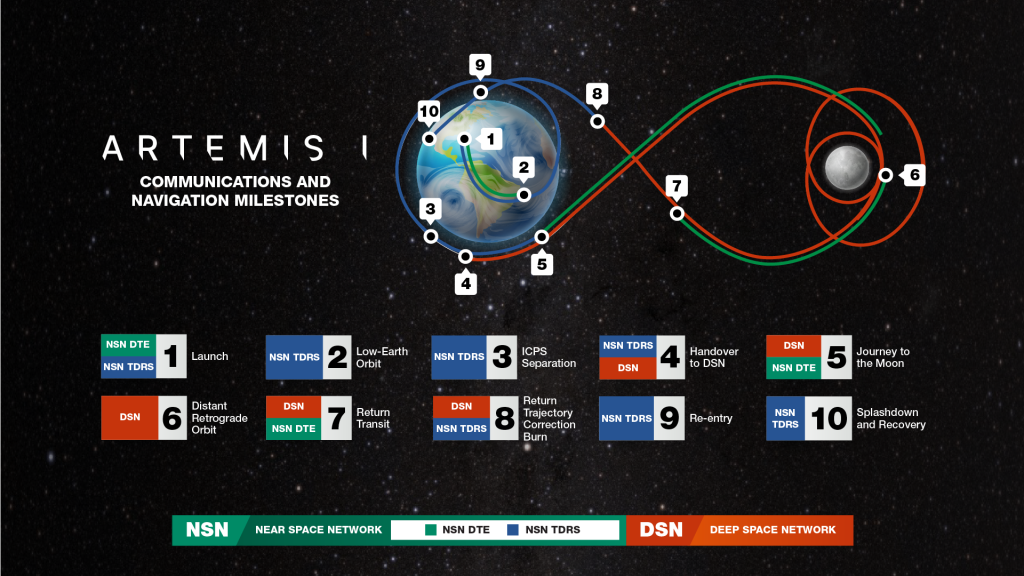
SCaN Lunar Support

Printed Engines Propel the Next Industrial Revolution

NASA Moon to Mars Architecture Art Challenge
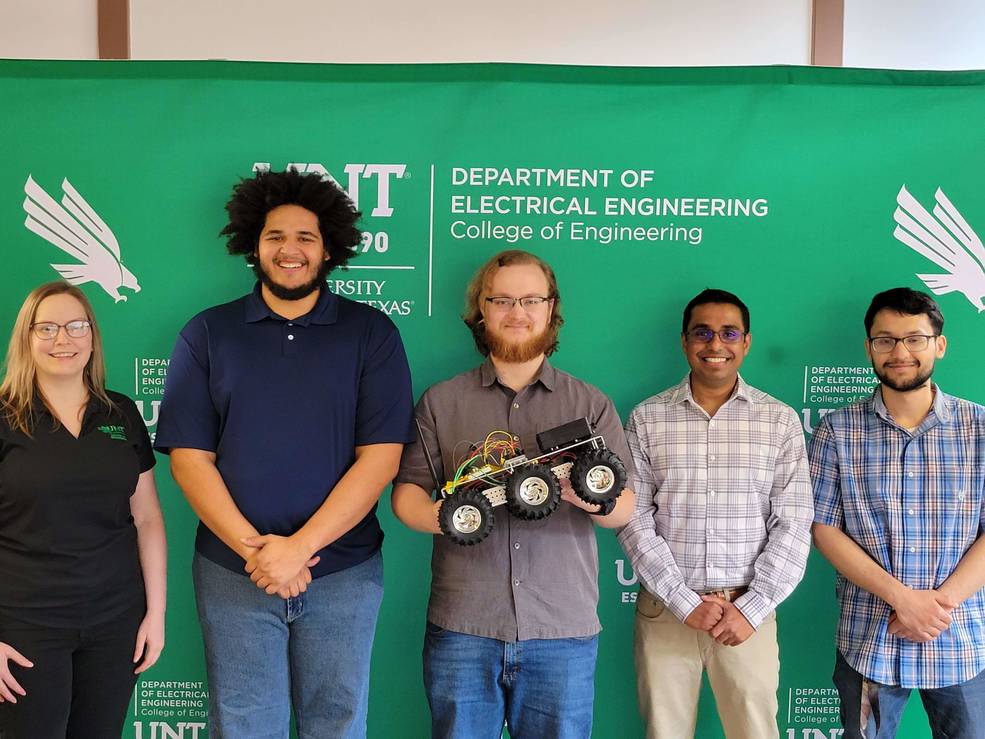
How to Apply to the NASA MINDS Challenge

15 Years Ago: Japan launches HTV-1, its First Resupply Mission to the Space Station

La NASA invita a los medios al lanzamiento de Europa Clipper

El X-59 de la NASA avanza en las pruebas de preparación para volar

La NASA invita a creadores de las redes sociales al lanzamiento de la misión Europa Clipper
Nasa to test telemedicine, gather essential health data with polaris dawn crew.
Dina F. Maron
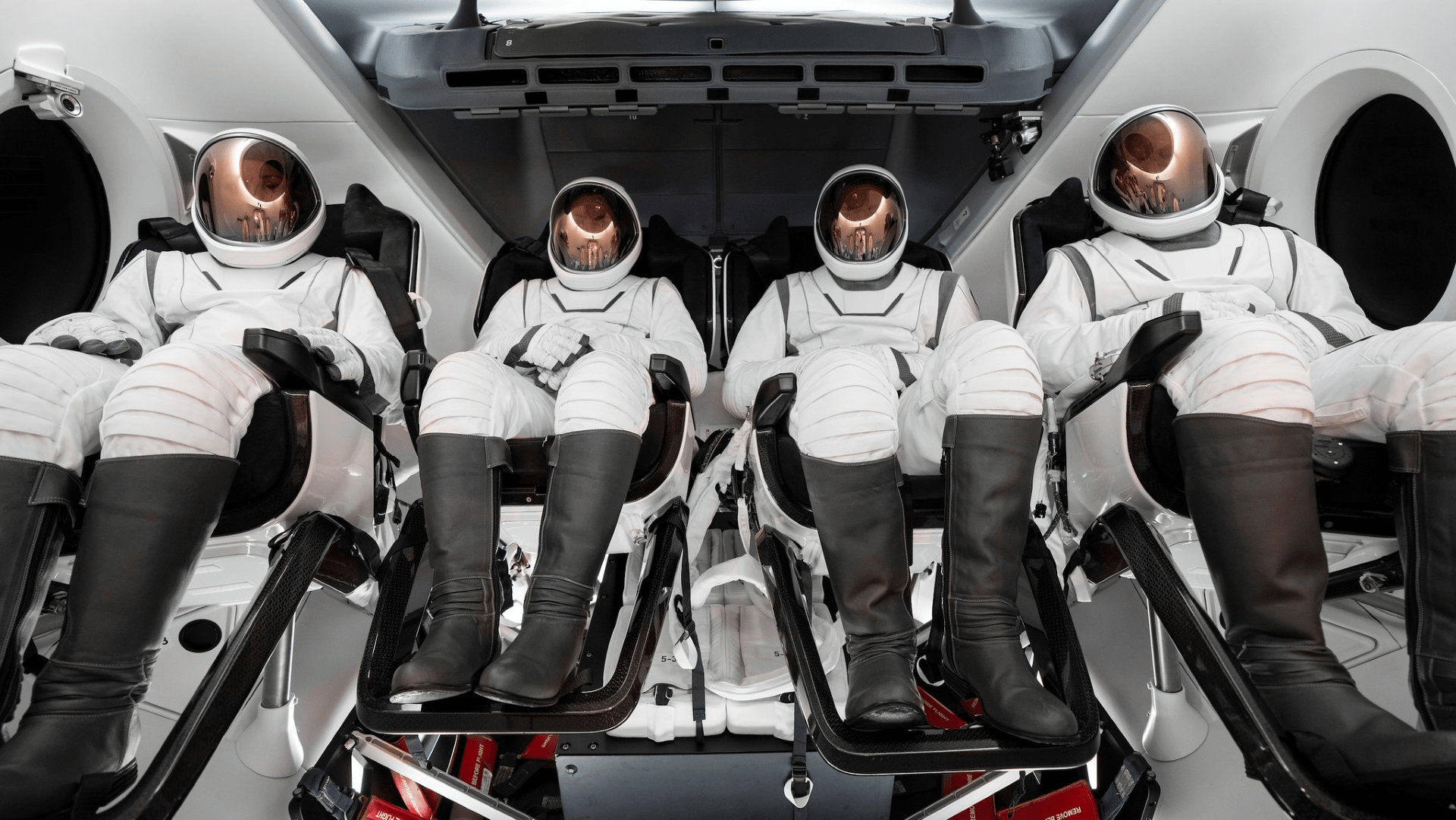
NASA researchers will soon benefit from a suite of experiments flying aboard a new fully-commercial human spaceflight mission, strengthening future agency science as we venture to the Moon, Mars and beyond.
The experiments are flying as part of the Polaris Dawn mission which launched aboard a SpaceX Dragon spacecraft and Falcon 9 rocket earlier today.
The four-person Polaris Dawn crew of Jared Isaacman, Scott “Kidd” Poteet, Sarah Gillis, and Anna Menon will conduct science during the mission including essential health and human performance research for NASA’s Human Research Program . The research will help NASA scientists better understand how exposure to space conditions affects the human body. The crew will test new medical approaches and technology on telemedicine capabilities, gather data on space motion sickness, and better characterize flight-associated injury risks.
“Each mission, whether the crew is comprised of commercial or NASA astronauts, provides a key opportunity to expand our knowledge about how spaceflight affects human health,” said Jancy McPhee, associate chief scientist for human research at NASA. “Information gathered from Polaris Dawn will give us critical insights to help NASA plan for deeper space travel to the Moon and Mars.”
The crew will test drive , a commercial device that can collect and integrate measurements of health, including blood pressure, heart rate, respiration rate, and temperature. The technology also provides ultrasound imaging and larynx and throat-focused video camera capabilities, and includes an experimental telemedicine feature that could help diagnose crew members in near-real time.
To test this technology during the mission, crew members will compare vital sign collection from the device with data gathered from standard periodic health status exams. The technology’s telemedicine feature, which relies on SpaceX’s Starlink communications system to connect with doctors and specialists on Earth, will also be tested during a simulation. During the test, the device will attempt to offer an appropriate diagnosis based on crew inputs and available documentation .
“Crew members will need to be more self-reliant during lengthy missions, and we hope that telemedicine can provide crews with assistance,” said McPhee.
Another research project aims to better understand and prevent the motion sickness symptoms that many astronauts experience in space. Participating crew members will describe their motion sickness symptoms, what interventions they tried to alleviate their symptoms, and whether any approaches helped.
A separate NASA-based research project will survey crew members after their mission to see whether they experienced any injuries or discomfort during re-entry to Earth.
“Our team will take the crew’s survey data and combine it with information gathered from sensors on the spacecraft. This will allow us to link crews’ reported experiences and health outcomes with the spacecraft’s dynamics and landing loads,” said Preston Greenhalgh, an injury biomechanist at NASA who is leading this work.
Crew members also will participate in a variety of other health studies on behalf of the NASA-funded TRISH (Translational Research Institute for Health), a consortium with various academic institutions. As part of that work, the Polaris Dawn mission will set a new baseline for collecting standard health data on commercial spaceflights, creating a complement to the datasets routinely collected from NASA astronauts and missions.
Polaris Dawn crew members participating in these TRISH studies will provide data about how spaceflight affects mental and physical health through a rigorous set of medical tests and scans completed before, after, and during the mission. The work will include assessments of behavior, sleep, bone density, eye health, cognitive function, and other factors, as well as analysis of blood, urine, and respiration.
“We’re so grateful to the crew members who volunteer to be part of NASA’s work. The insights that we gain from each study may trigger breakthroughs that will help ensure future mission success,” said McPhee.
NASA’s Human Research Program pursues the best methods and technologies to support safe, productive human space travel. Through science conducted in laboratories, ground-based analogs, commercial missions, and the International Space Station, the program scrutinizes how spaceflight affects human bodies and behaviors. Such research continues to drive NASA’s mission to innovate ways that keep astronauts healthy and mission-ready as space exploration expands to the Moon, Mars, and beyond.
Explore More

At first glance, it seems like a scene from an excursion on the Moon’s surface…except…

Out-of-this-world phenomena NASA astronauts will experience at the Moon’s south polar region.
Discover More Topics From NASA
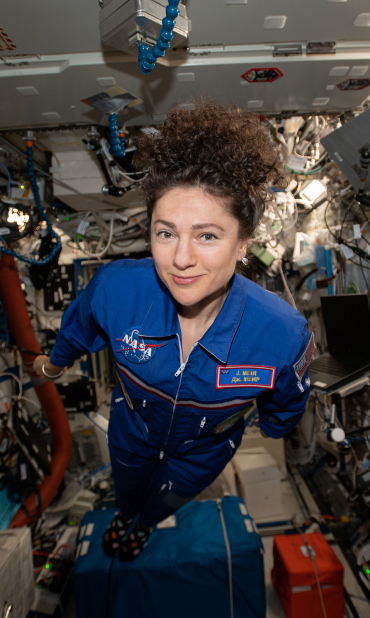
Human Research Program

Space Station Research and Technology


IMAGES
VIDEO
COMMENTS
The use of non-human animals in biomedical research has given important contributions to the medical progress achieved in our day, but it has also been a cause of heated public, scientific and philosophical discussion for hundreds of years. This review, with a mainly European outlook, addresses the history of animal use in biomedical research ...
Introduction. Annually, more than 115 million animals are used worldwide in experimentation or to supply the biomedical industry. 1 Nonhuman animal (hereafter "animal") experimentation falls under two categories: basic (i.e., investigation of basic biology and human disease) and applied (i.e., drug research and development and toxicity and safety testing).
There are several reasons why the use of animals is critical for biomedical research: • Animals are biologically very similar to humans. In fact, mice share more than 98% DNA with us! • Animals are susceptible to many of the same health problems as humans - cancer, diabetes, heart disease, etc. • With a shorter life cycle than humans ...
For some types of research, animals must be engineered to have or lack certain genes (or the proteins made by these genes) in order to determine what role a gene and its protein might play in disease development. This is not possible to do in humans for legal, ethical, and scientific reasons. Researchers often recreate many serious diseases ...
Introduction. Animal model-based research has been performed for a very long time. Ever since the 5 th century B.C., reports of experiments involving animals have been documented, but an increase in the frequency of their utilization has been observed since the 19 th century [].Most institutions for medical research around the world use non-human animals as experimental subjects [].
Animals provide a way to study the fundamental workings of the human body and explore how its basic building blocks—molecules and cells—work in health and disease. In doing so, researchers can unravel the most basic mechanisms that fuel illness. Animal models help researchers understand how the normal processes in molecules, cells, and ...
The use of non-human animals in biomedical research has given important contributions to the medical progress achieved in our day, but it has also been a cause of heated public, scientific and philosophical discussion for hundreds of years. This review, with a mainly European outlook, addresses the history of animal use in biomedical research, some of its main protagonists and antagonists, and ...
Abstract. The use of non-human animals in biomedical research has given important contributions to the medical progress achieved in our day, but it has also been a cause of heated public, scientific and philosophical discussion for hundreds of years. This review, with a mainly European outlook, addresses the history of animal use in biomedical ...
There is overwhelming scientific consensus worldwide that some animals are still needed in order to make medical progress. Where animals are used in research projects, they are used as part of a range of scientific techniques. These might include human trials, computer modelling, cell culture, statistical techniques, and others.
Medical Progress and Biomedical Research The Nobel Laureates. Every Nobel Prize in Medicine awarded in the last three decades was dependent on data from animal models. Overall, 83% of the Nobel Prizes awarded for outstanding contributions to medicine have involved animal research since the program was founded in 1901, more than 100 years ago.
Animal experiments have been vital in the development of many vaccines, including polio and of course, the COVID-19 vaccine, the isolation and use of insulin, the discovery of a vaccine for canine parvovirus (which causes a lethal infection in dogs) and other advances that have saved the lives of humans and animals.
Animal experiments in biomedical research are debated in public, within the scientific community and among students. Despite increased efforts to reduce, refine and replace animal experiments, they remain integral components of the job of a biomedical scientist. ... Knowledge, self-evaluation and attitudes of biology and medical students Lab ...
Animal research is considered a key element in advance of biomedical science. Although its use is controversial and raises ethical challenges, the contribution of animal models in medicine is essential for understanding the physiopathology and novel treatment alternatives for several animal and human diseases. Current pandemics' pathology, such as the 2019 Coronavirus disease, has been ...
animal experiments. ethics. animal use. Mankind has been using animals already for a long time for food, for transport and as companion. The use of animals in experimental research parallels the ...
The significance and challenges of animals in biomedical research. There has always been a debate among the researchers about the significance of animal models, as many experiments yield promising results, whereas, others couldn't produce desired outcomes, so, that model could be translated to humans too.
Most of the animals needed for medical and scientific inquiry in the U.S. are rodents (for example, rats and mice), and they are specifically bred for this purpose. Dogs, cats, and nonhuman primates together account for less than 1% of all animals necessary for medical research. A wide variety of other species make up the remaining 4%, from ...
To many people, animal research represents a doorway to the medical treatment of tomorrow. But to animal protectionists, and a growing number of other Americans, animal experimentation is a barbaric, outdated practice that—on the basis of a few notable past successes—has somehow retained its vestigial acceptability.
A Pew Research Center poll found that 52 percent of U.S. adults oppose the use of animals in scientific research, and other surveys suggest that the shrinking group that does accept animal experimentation does so only because it believes it to be necessary for medical progress. 5,6 The majority of animal experiments do not contribute to ...
Animal experiments are part of medical history, but history is where they belong. Compared to today's potential to understand the basis of human disease at cellular and molecular levels, experimenting on live animals seems positively primitive. So if we want better quality medical research, safer more effective pharmaceuticals and cures to ...
The principle of 3R—to replace, reduce and refine the use of animals in research—was formulated more than 60 years ago (Russell & Burch, 1959).It has been continuously adapted and modified since and found increasing acceptance as the ethical and legal basis for regulating animal experimentation, most prominently in the EU (Parlament & Rat der Europäischen Union).
A February 2021 YouGov poll, which was commissioned by Animal Free Research UK, found that 60% of respondents would support the British Government providing more financial support for developing alternatives to experimenting on animals in medical research; 68% of respondents would support a policy ending animal experiments in medical research ...
The use of animals in research is currently an essential component of the drug discovery process. ... Replacement of animal with non-animal experiments, such as mathematical models, computer ... social interaction, and medical attention for our animals, 365 days a year. All of our research animals are provided with: Specially formulated diets ...
Technologically advanced non-animal research methods—such as those using human cells, computational models, or clinical studies—can be used in place of animal testing. These methods are more humane, have the potential to be faster, and are more relevant to humans. Scientists in PETA's Science Advancement & Outreach division, a part of the Laboratory Investigations Department, have ...
Dedicated 3R centres support and accelerate the transition to non-animal models in biomedical research. ... 3R centres contributions to change animal experimentation: A field report from Charité 3 R, the 3R centre of a medical faculty.
Animal studies have been an essential component of every field of medical research and have been crucial for the acquisition of basic knowledge in biology. In this chapter a few of the contributions of such studies in biomedical and behavioral research will be chronicled. These descriptions should be viewed within the context of the vast improvements in human health and understanding that have ...
The experiments are flying as part of the Polaris Dawn mission which launched aboard a SpaceX Dragon spacecraft and Falcon 9 rocket earlier today. The four-person Polaris Dawn crew of Jared Isaacman, Scott "Kidd" Poteet, Sarah Gillis, and Anna Menon will conduct science during the mission including essential health and human performance ...